 Marine Nationale 1947-1991
Marine Nationale 1947-1991
Until its WW2 ships came out of service, the French Navy in the early cold war needed about ten years to recover a shipbuilding capability in order to deliver new capital ships: Two cruisers and a battleships were completed on modernized designs, several war reparation vessels integrated, others modernized, and in 1961, the fleet welcomed its first domestic aircraft carriers since the 1920s, which became the center of two task forces.
In 1966 however, General de Gaulle decided to withdraw from NATO integrated command, while pursuing the French nuclear deterrence program, notably relying on SSBNs and SSNs, making the “hexagon”, the world’s fourth nuclear power. Other landmarks includes the Suffren class missile destroyers, France’s first nuclear-powered aircraft carrier built from 1987, and after the end of the cold war, the first stealth frigates of the Lafayette class. Export-wise, France also count on a large military industrial complex, with naval group and specialists such as MDBA (now Euromissiles), Dassault and Aerospatiale (now Eurocopter) for the air component, Thales for electronics, or SEMT Pielstick for marine diesels. More than ever today it is part of a network of multinational programs under the European flag.
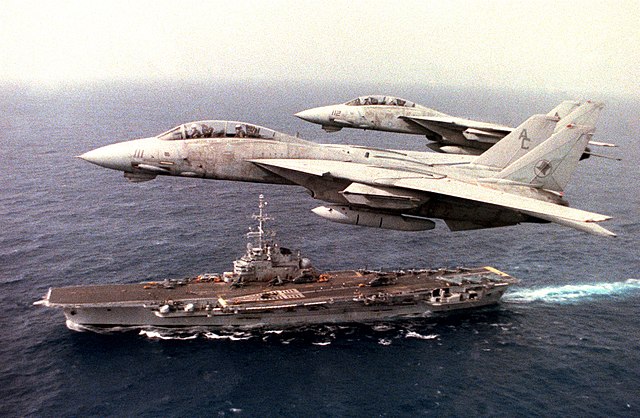
F-14 Tomcats over FS Foch, during a joint exercise USS JOHN F. KENNEDY (CV 67) operated together. Photo by Commander J. Leenhouts (cc)
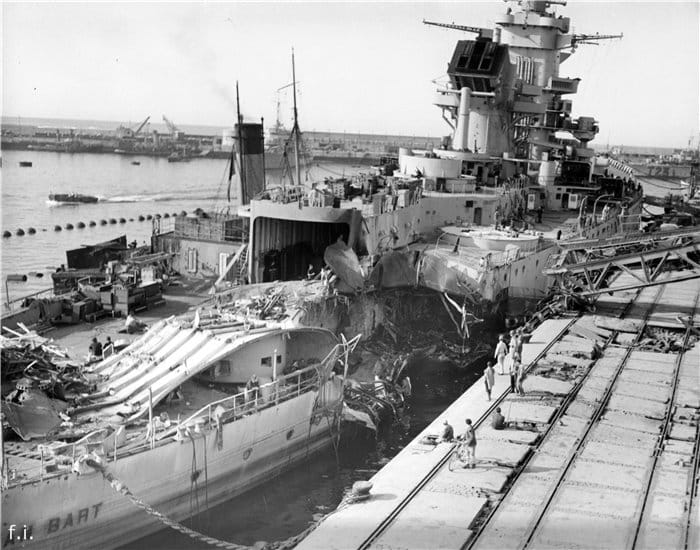
Jean Bart laid to rest at Casablanca, after Operation Torch Nov. 16, 1942. Photographed by USS Chenango (ACV-28). Official U.S. Navy Photograph, now in the collections of the National Archives. (cc)
Articles, done and upcoming
- Agosta class submarine (1977)
- Arethuse class submarines (1956)
- Cassard class Frigates (1985)
- Clemenceau class Aircraft Carriers (1957)
- Daphné class submarines (1959)
- De Grasse (1946)
- Duperré class destroyers (1956)
- FS Aconit
- FS Arromanches (1946)
- FS Charles de Gaulle (R92, 1994)
- FS Jean Bart (1940)
- Georges Leygues class Frigates (1976)
- Gymnote (1964)
- Jeanne d’Arc (1961)
- La Galissonnière (1960)
- Le Redoutable class SSBN
- Narval class submarines (1956)
- Rubis class SSN (1979)
- Suffren class Frigates (1965)
- Surcouf (T47) class destroyers (1956)
- The Missile Cruiser Colbert (1953-1991)
- Tourville class Frigates (1972)
Aircraft/Helicopter carriers
- PA 28 class project (1947)
- PH 75 class (1975)
- Chateaurenault class (1950)
- Le Corse class (1952)
- Le Normand class (1954)
- Cdt Riviere class (1958)
- Estiennes D’Orves class (1973)
- Cassard class (1985)
- Lafayette class (1990)
- Estiennes D’Orves class (1973)
- Floreal class (1990)
- La Creole class (1940)
- Narval class (1954)
- Arethuse class (1957)
- Daphne class (1959)
- Gymnote test SSBN (1964)
- Le Redoutable SSBN (1967)
- Agosta SSN (1974)
- Rubis SSN (1979)
- Amethyste SSN (1988)
- Le Tromphant SSBN (started 1989)
- Issole (1958)
- EDIC class (1958)
- Trieux class (1958)
- Ouragan lass (1963)
- Champlain lass (1973)
- Bougainville (1986)
- Foudre class (1988)
- CDIC lass (1989)
- Le Fougueux class (1958)
- La Combattante class (1964)
- Trident class (1976)
- L’Audacieuse class (1984)
- Grebe class (1989)
- Sirius class (1952)
- Circe class (1972)
- Eridan class (1979)
- Vulcain class (1986)
Cruisers
Frigates
Corvettes
Submarines
Amphibian Ships
Misc. ships
Situation in 1945
The French post war fleet was a mix of surviving units passed under the free French control and allied units passed from either the royal navy or in large majority the US Navy Freighters already were of us construction including former liberty ships that helped French postwar trade until the 1960s. France was left impoverished and with all its shipyards in ruins, as well as its industries, and qualified manpower returned either from POW camps or compulsory work service (STO).
Of course, this situation was not going to last. After 1946, the Marshall plan helped France rebuilt her ravaged economy and in the late-40s – early 1950s and two shipyards were able to produce the first postwar destroyers, the T47. The French navy passed through the same evolution process from conventional to missiles types in the 1960s and even became a recognised missile manufacturer. A good example of this is the Colbert at first completed as an AA cruiser like the De Grasse but later gradually reconstructed as a missile cruiser used as an escort for the new Clemenceau class aircraft carriers.
There were a significant number of vessels that were in needs of completion and were completed in the late 1940s to early 1950s often fully rebuilt.
The most spectacular cases were the battleship Jean Bart and cruisers Tourville and Colbert.
The Jean Bart was the sister-ship of the Richelieu and spectacularly escaped to avoid capture in 1940. It was then relegated to Casablanca for the duration of the war even exchanging fire with us battleship Massachusetts during operation torch.
There were concerns about what to do with after the war when it was clear that battleships were definitely out of the equation of modern naval warfare. After much debate, it was eventually decided to convert her as an anti-aircraft battleship for task force escort.
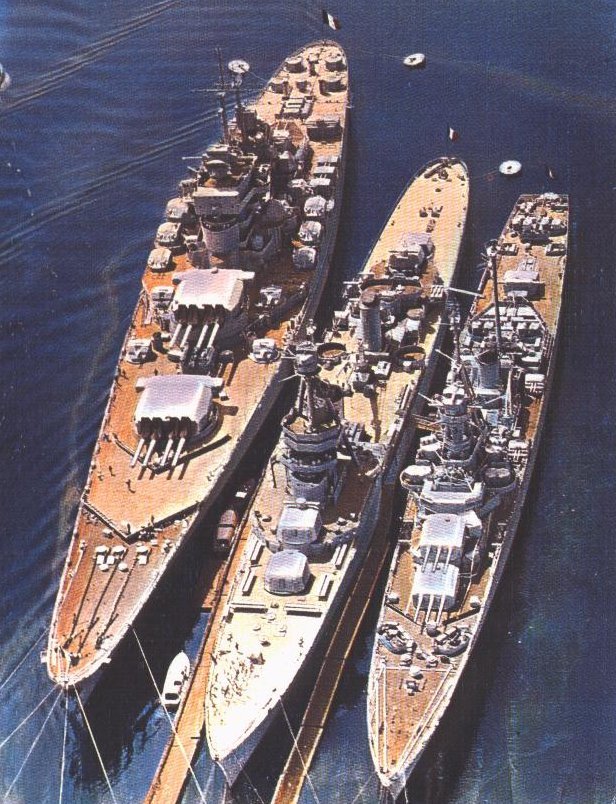
The “old guard” of the French early cold war navy: Battleship Jean Bart, cruisers Suffren and Montcalm in the early 1960s, pending scrapyard. This is a fairly well-known photo around the internet, but of unknown origin. Please comment if you have a clue.
For that purpose, the Jean Bart was entirely rebuilt but still kept its main battery. Telemetric systems tailored to serve the many anti-aircraft batteries were installed, the main gun battery fire direction system was entirely revised and a new superstructure set in place. The redesign and full conversion process took a while but eventually, the conversion had more potential than the contemporary British vanguard or the Iowa class for that matter.
Despite of this, the Jean Bart career was rather short but the ship would serve with distinction in the 1956 Suez canal operations.
Other interesting conversions at that time were the cruiser De Grasse and Colbert.
The two had been designed as large gun platforms before the war with triple turrets but this also was seen as no longer relevant after the war and the same reconstruction and reconversion process took place. Both indeed were converted as AA cruisers for aircraft carrier escort. However with rapid progress in jet propulsion, artillery was soon obsolete, and missiles look the way forward. Only the Colbert, in the end, will be converted between 1970 and 1972 as a missile cruiser, while both the De Grasse and Jean Bart went to the depot, and soon disappeared from view in the late 1960s.
Postwar allocations
Another aspect of the French cold war Navy, besides the numerous British and US-built ships she maintained, was the generous allocation she received in war reparations. Ships in Good state, recent, powerful, has been allocated to her in priority as a special favour some found unjustified, like the Soviets, arguing their participation in the war has been all but symbolic at best. Nevertheless these served for years, helping to maintain a fledgling French Empire and its position into NATO.
Such ships has been the wartime aircraft carrier Dixmude (HMS Biter) transferred in 1945, the Arromanches (HMS Colossus) transferred in 1946 and purchased in 1951, and the same year, with the situation deteriorating in Indochina, Lafayette, ex-USS Langley (Independence class) and in 1953, Bois Belleau (USS Belleau Wood). These ships operated mostly piston aircraft of US and British design, fully compatible or early jets.
War Reparations
To this, the French also received two ex-Italian cruisers in 1949 (Chateaurenault & Guichen, of the 1943 Attilio Regolo class, modernized and rebuilt) and four ex-Soldati class DDs named Jurien de la Gravière, Duperré, Ducchafault, and D’Estaing acquired in the summer of 1948, seeing about 6-10 years of service.
These were also nine ex-German destroyers and large TBs named Marceau, Kléber, Hoche, Desaix, Alsacien, Lorrain, Dompaire, Bir Hakeim and Baccarat. Also the U-Bootes Laubie, Mille, Blaison, Bouan, were modern VIIC models of 1943-44 and the Roland Morillot, one of the famous XXI type, which helped the French designing their first modern coldwar submarine type.
Allied transfers
Six British Frigates and six US Destroyer Escorts were also transferred, named Algerien, Senegalais, Somali, Hova, Marocain, Tunisien, L’Aventure, Surprise, L’escarmouche, Croix de Lorraine, Tonkinois and La Découverte, and 15 ex-German minesweepers (1937-41) and also 30 wooden YMS type minesweepers*, and 30 US PC type 280 t sub-chasers. These types, in particular, were to bring France a much-needed breathing space over which the Marine Nationale could set up a modernized naval production, integrate new maintenance and training procedure and work out early domestic designs, but also make her contribution to the NATO efforts in the western and Mediterranean seas. Of course in 1958 this changed dramatically with the arrival of De Gaulle and France leaving NATO.
*One ships in particular rose to fame postwar: BYMS-26, used in the Royal Navy from 1942, returned to the US and decommissioned in 1946. She was purchased by Joseph Gasan of Malta and renamed Calypso to serve as a ferry, one year later, British millionaire and former MP, Thomas Loel Guinness, bought Calypso and leased to J.Y.Cousteau for a symbolic Franc. Keeping its name, the ship became a world’s famous oceanic exploration vessel.
France leaves NATO: 1960s policy
With the arrival of De Gaulle at the head of government in 1958, tackling both a painful but necessary exit from the Algerian war of independence and domestic turmoil like an aborted putsch attempt, a new constitution was setup and a new independent policy was established, which needed both to leave NATO and to develop a domestic nuclear program.
NATO withdrawal 1959-69
De Gaulle contested both the representation of France in the NATO command structure and her role in the naval branch, the AFMED command. The withdrawal of French naval forces from NATO was an ongoing process starting in 1959, followed by the early 1960s by the Atlantic and Channel commands, then the other arms until 1969 and the obligation for all NATO presence to leave France. Due to this new policy, completely new priorities had to be devised for the Marine Nationale, whereas NATO had to rethink its local contributions without France. From then on, De Gaulle launched the most ambitious French military program to date, called Force de Dissuasion.
Read More
The French ‘Dissuasion force’ (Deterrence)
It needed to establish, in full autonomy from Washington, the development of an independent nuclear program, including civilian and military aspects, the consequences were far-reaching. The French nuclear complex is still a powerful lobby today. The second aspect of this was the development of a domestic assault and intervention force, with considerable amphibious assets. This went beyond the definition of new aircraft carriers, with the design of large versatile assault ships.
The dissuasion force took several ways, from the construction of two-stage intercontinental missiles (installed 1966-96 in Albion plateau, SE France), airborne capability (Mirage IV then Mirage 2000N) and of course a consistent SSBN force protected by SSNs, calibrated to the size of the Royal Navy’s.
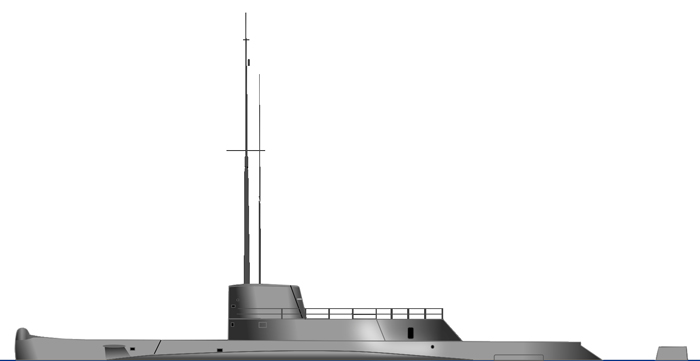
French Gymnote (1964, first generation test SSBN) – Credits Rama – CC
French SSBNs
The French submarine program stuck to conventional diesel-electric types through the Creole, Narval, Arethuse and Daphne types, before building in 1963-66 the Gymnote, a ballistic trial submarine equipped with four SLBM tubes. Even two years before her entry into service, the keels of six SSBNs were laid down in succession (1964-1980) at Arsenal de Cherbourg, leading to the construction of the Le Redoutable class. These 8500 tons boats were able to carry 16 ballistic missiles, 18t, two-stage M1 equipped with a single 500 kt warhead, 2500 km range, comparable to the American Poseidon system.
The third boat introduced the 3000 km range M2, and in 1976, the M20 with a 1Mt warhead (fourth boat). Apart the Le Redoutable stricken in 1991, the five others were in service by 1995. Being 25 years old, their replacement was studied already from 1985. At last in 1989 was laid down the keel of the first of a new serie of very large oceanic, stealth SSBNs, displacing 14.200 tons, quite a leapfrog in capabilities. The Le Triomphant class has since replaced all 1960-70s boats, all capable to fire sixteen M5 carrying each 12 TN-75 MIRV SLBMs.
French SNAs
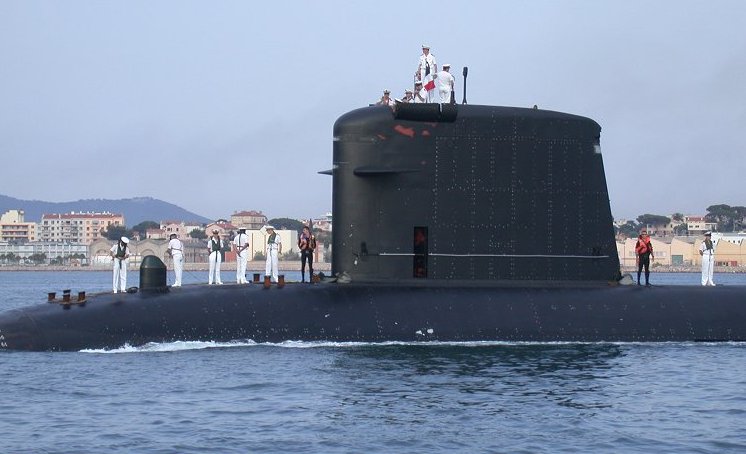
Submarine Saphir returning from mission in 2002 – Photo JM Roche. Photo courtesy and autorisation of www.netmarine.net CC licence
To hunt for enemy submarines able to threaten this dissuasion force, two classes of new generation submarines were delivered. In the 1970s, the Agosta type, last French diesel-electric type, and the Rubis class SNAs in the early 1980s, followed by the two Amethyste class in the early 1990s (the first as laid down in 1984, and the next two were cancelled). They were replaced in the 2000s by a serie of the large Barracuda class, new generation SNAs, comparable to the US Los Angeles of the last series in size, but Seawolf in capabilities. The preliminary design studies went back to the late 1980s as it was though to shorten and adapt the new SSBNs of the Le Triomphant type.
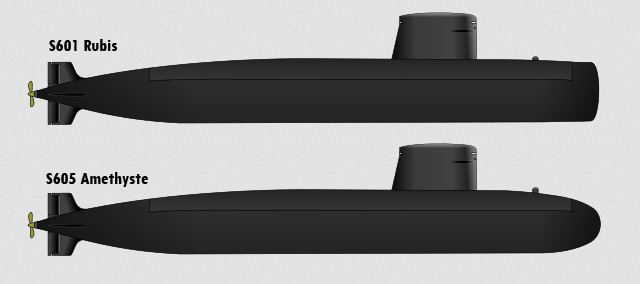
Montage of two French SNA – Profiles from Rama – CC
The 1969 Plan Bleu
Despite the departure from power of De Gaulle, his party clung to its traditional prefference over a strong national defence, an some defiance towards NATO and the US. The sea based deterrence components went on with the utmost priority. However this long commitment started to have consequences over French conventional forces, not only the Navy, which started to experience a lack of maintenance, R&D, renewal. Obsolescence was the main concern in the admiralty, loudly voiced over and the 1950s fleet was ageing fast. Despite conversions and modernizations, there was no replacements in sight. The 5-years plans has been contingented by budgetary balance and failed to deliver the awaited renewal.
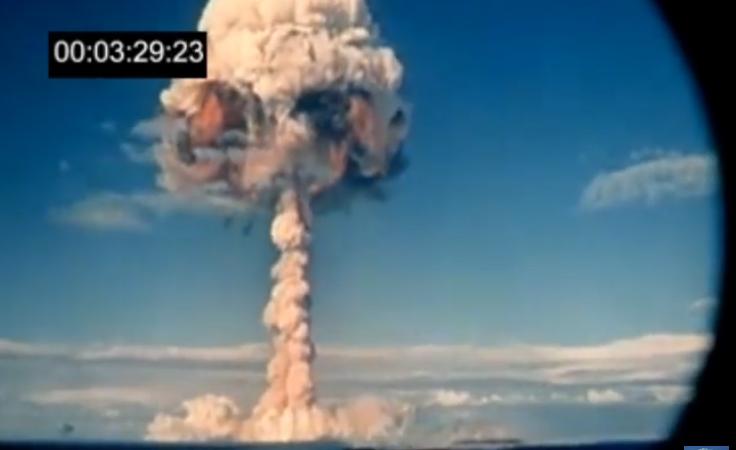
At some point a longer, bolder naval plan was established called the “blue plan”. Formulated in 1972, it called for 1985 a fleet comprising five SNLE, two aircraft carriers, two helicopter carriers, 30 frigates and corvettes, two tankers, twenty SSK/SSN submarines, 35 sloops, 36 MHC/MSC, 50 LRMP aircraft, 2 new LHC, new LCU and LSTs, 85,000 tons of supply ad logistics. As ambitious as it was, it was tailored to carry out the deterrence mission, constitute a coherent and powerful conventional blue water navy, but also to defend French coastal areas and overseas territories. The latter point included a permanent and stronger presence in Mayotte, Djibouti and La Reunion. The cornerstone of the last point were to be the new A69 ‘avisos’ (sloops), carrying out ASW and patrol missions, FPB making the coastal component. In 1980 this helped to create a French Indian Ocean squadron 20 ships strong.
Another point for the conventional blue water navy was the use of four carriers, including the new helicopter ones, used also as assault and ASW ships. The C70 Corvettes were to replace the T47 to 56 escort frigates, based on a scaled-down version of F67 (Tourville) destroyers. But the plan soon was hit by reductions: One helicopter carrier (the one left was Jeanne d’Arc), 8 Corvettes and 8 attack submarines. Delays accumulated however, caused by budgetary choices and exports which had priority over national needs. Fundings were still drained at 26% by FOST (nuclear detterence). Compounding this were the cost explosion of technological developments, part of the modernization of all programs, always made locally.
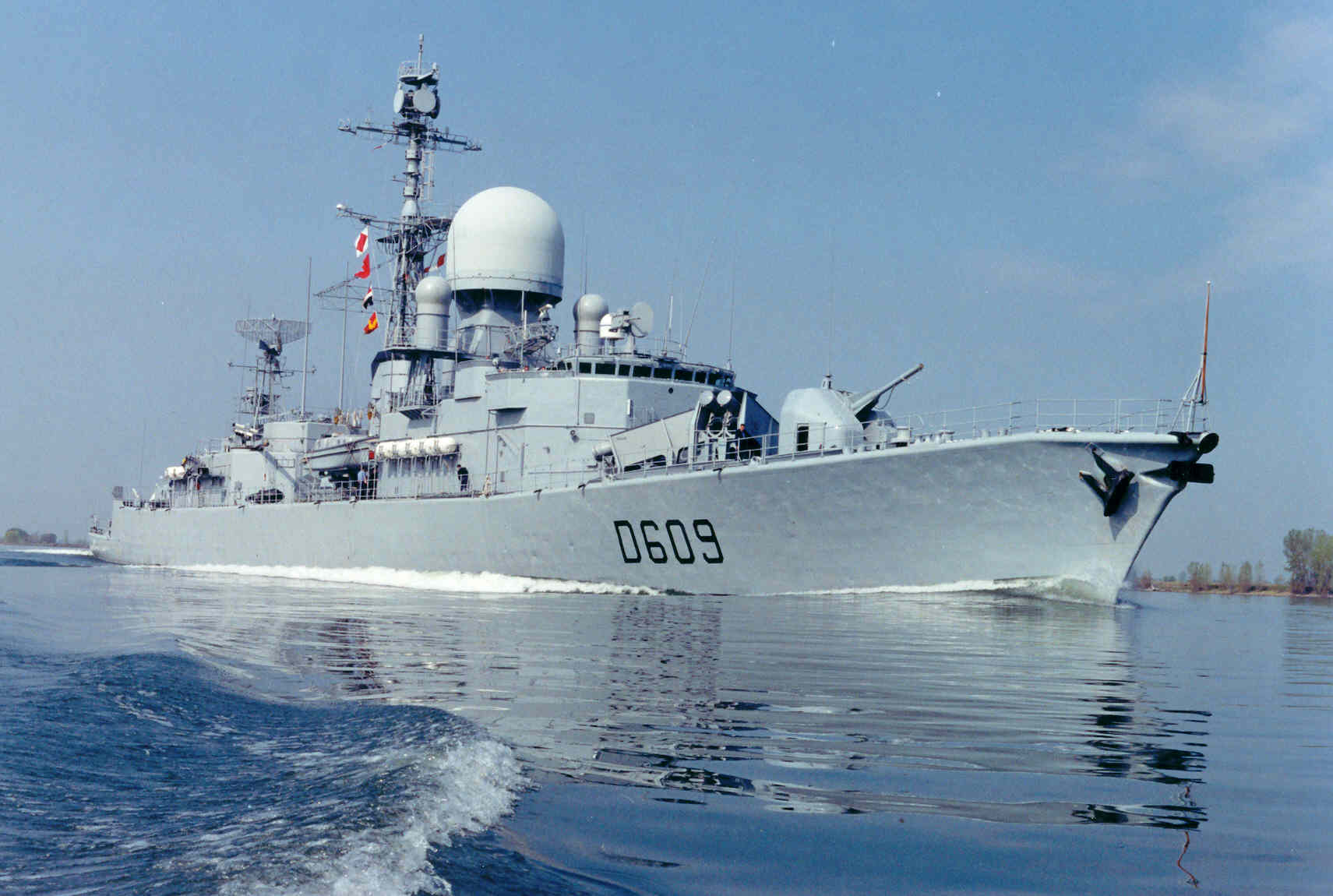
The end of the cold war (1985-91)
At the end of the eighties, the old Cdt Riviere class Frigates needed replacement, and the Navy experimented a budget-savvy measure for the first time, by using commercial-grade hulls in serie to lower costs. This was the Floréal class Corvettes (launched 1990). This indeed allowed cost-savings by ordering them to private shipyards to lighter specs. After 30 years of use, as of today the formula was not that such a good move for the admiralty and there has been a return back to more military-grade efficiency. The success of the formula at the time however motivated later the building of five new ASW/assault carriers (Mistral class).
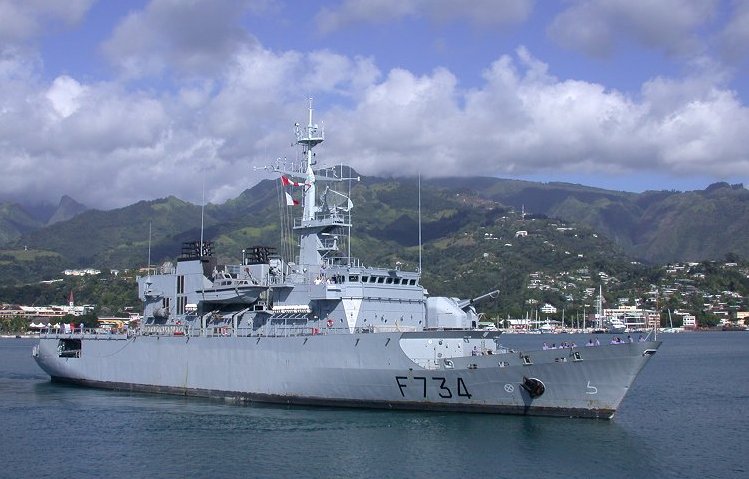
The cheap Floréal has been a welcome complement to the costly and innovative stealth frigates of the Lafayette class (1992), delayed for long. These stunning ships launched a fad for stealth surface warships which is widespread now, and sold well. They were followed by the more ambitious vessels of the FREMM program shared with Italy. Today the balance is shifting towards an intermediary between the Floréal and Lafayette with the 2020 Frégate de Défense et d’Intervention (FDI).
The end of the cold war has many consequences and of course first of all a drastic budget reduction. The first to be hit was the Charles de Gaulle nuclear aircraft carrier, delayed for five years. Cancellations also with the last two SSNs of the Amethyste class, two more Foudre class LPDs, and the whole BAMO oceanic minehunters serie.
In addition these cuts prevented the replacement of archaic fighters such as the naval F-8 Crusader, retired in the US since the 1970s. The replacement was the naval version of the Rafale, which despite receiving priority took years to be serviceable. At last reflecting the urgent need of the conventional force, FOST budget was reduced to 25% of the total and the new Le Triomphant class SSBN was delayed, together with two cancellation in the class.
Command structure
The Marine Nationale is managed through four Maritime zones, all coordinated by the CEC.LANT Headquartered at Brest, Britanny for the Atlantic and CAC.MED at Toulon for the Mediterranean. The C-in-C for the Indian Ocean is named AL.INDIEN and the one for pacific, based in Papeete (Tahiti) is called AL.PACI. French national territory maritime subdivision comprised three Prefecture Maritime. Following the end of the cold war, the area-based division was dropped and forces were separated between organic role instead: The main blue water task force under FAN (Force d’Action Navale), a versatile, global projection force, based in Toulon.
It comprised the bulk of the surface fleet, carriers and their escorts and SNAs. The GASM for Grupe d’Action Sous-Marine was the second force comprising 6 ASW Frigates and 10 Avisos dedicated to ASW warfare, and the FOST nominally with four SSBNs based at Brest. In addition, also at Brest was the Force de Guerre des Mines (FGM), the minehunting force.
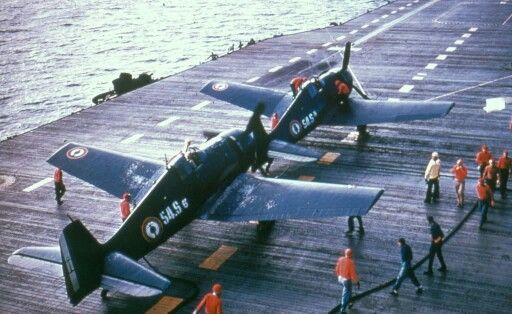
French Fleet Air Arm
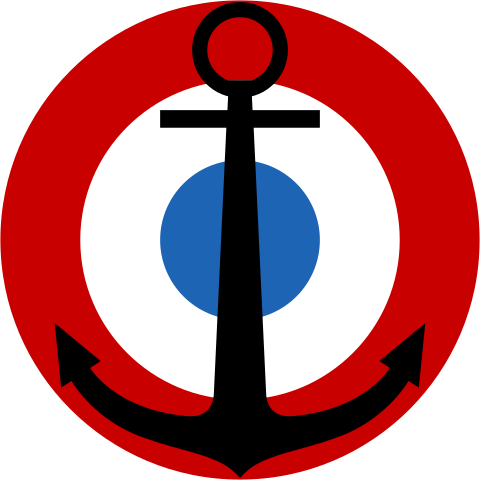
The French Aéronavale was born when testing air reconnaissance on the cruiser Foudre in 1912, and was really started with the commission of the aircraft carrier Béarn in 1927. It was revived at the end of the WW2 and soldiered in Indochina with US and British fleet air arms planes, ranging from the PBY Privateer to the Catalina, Hudson, and many classic fighter-bombers of the USN, from Vindicator to the SBD Dauntless, Helldiver, Hellcat and Corsair, Seafire, before jumping into the Jet age with nationalized companies. One, Sud-Est or SNCASE (“South West”) licence-built the Aquilon, a copy of the De Havilland Venom.
The Aéronavale in Indochina (1948-55)
It would be too long as to cover each and every imported planes, so we will stick to a simple list. At some point, the Aéronavale operated simultaneously 15 plane types. There will be a dedicated post on the matter in the future. More can be seen also on www.Frenchwings.net.
-Vought SBD Vindicator
-Douglas SBD Dauntless
-Grumann F6F Hellcat
-Vought F8U Corsair
-Grumann TBU Avenger
-Grumann F8F Bearcat
-Supermarine Seafire
-Douglas Skyraider
-De Havilland 100 Vampire Mk.V
Larger planes:
-Avro Anson
-Avro Lancaster
-Consolidated PBY-5 Catalina
-Consolidated PB4Y-2 Privateer
-Lockheed P2V-1 Ventura
-Lockheed P2V-6/7 Neptune
-Martin P5M-2 Marlin
-Short Sunderland Mk.III/V
-Supermarine Sea Otter
-Supermarine Walrus
-Vickers Wellington
SNCASE Aquilon
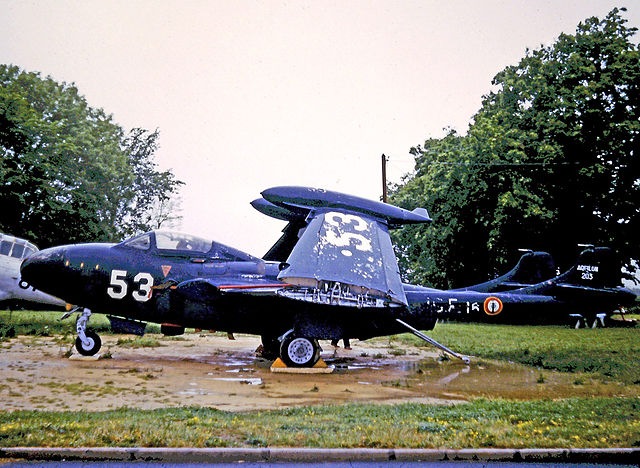
The first French Jet operated onboard French carriers was the De Havilland Vampire. Used from 1953 by the escadrille 57S, this was a good way to familiarize pilots on this basis, before swapping on the more modern De Havilland Venom (precisely the Sea Venom Mk20). The latter was an improved version of the VAMPIRE which was licence-built from 1952 by the nationalized Société Nationale de Construction Aéronautique du Sud-Est (SNCASE) based in Marignane. It was operational from 1955 to 1966, but not deployed apparently in Indochina, only over Algeria and during interventions over Bizerte. The Aquilon was operated from land bases, possibly from the Arromanches but also the Clemenceau class carriers. The Aquilon replaced the Hellcat but operated alongside the Corsair, used until 1966 as a close support fighter-bomber.
The Aéronavale during the cold war (1960-90)
In 1966, two important planes disappeared from the French Aéronavale: The early Jet SNCASE Aquilon and the old Vought Corsair. A new generation based on the Clemenceau class was on its way: On one side, the Dassault Etendard IV, which never was a fighter, and the high performances Vought Crusader, alongside the Fouga Zephir and Breguet Alize for ASW warfare, Alouette III helicopter for SAR.
Fouga CM175 Zephir (1956)
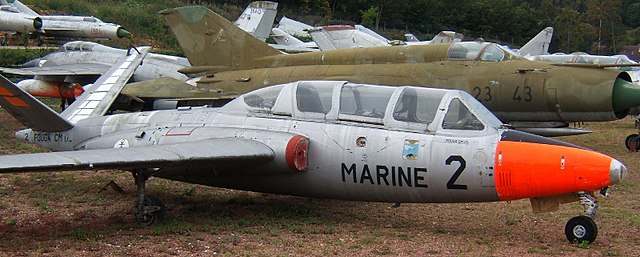
Derived from the Fouga Magister, this small and light jet trainer was propelled by the same Turbomeca Marboré engines and was given an arrester hook and a modified structure and undercarriage strengthened for carrier operations. It was introduced in 1959 and stayed frontline on land bases and onboard carriers until 1994. It has never been replaced, despite an attempt made on the Alpha Jet.
Dassault Etendard IV (1958)
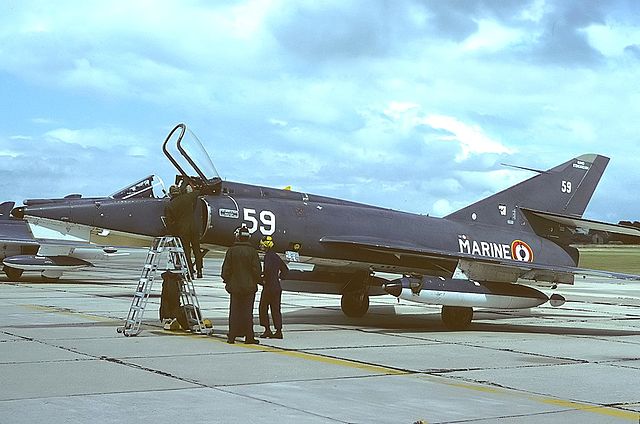
The second generation jet from Dassault was developed to replace the Mystere interceptor. It was degraded eventually into a light versatile fighter which also followed NATO guidelines for this type of craft, was evaluated by the French aviation and selected as a naval plane for reconnaissance, the prototype flying in 1956 already. The Etendard II was dropped and the model IV was eventually adopted and introduced on the Foch and Clemenceau and naval bases from 1960. Only ten tons, it was propelled by a SNECMA ATAR 08B turbojet engine which developed 43.16 kN (9,700 lbf) thrust.
It could carry various payload and be used for reconnaissance, support and attack, but was not a high performance fighter by any margin. Maximum speed was just 1,099 km/h (683 mph, 593 kn), Range 3,300 km, ceiling: 15,500 m, rate of climb: 100 m/s. Two main variants were used: The IVP for reconnaissance and IVM form bombardment. The Etendard could carry a pair of AIM-9 Sidewinder/Matra or Nord AS.30/AS.20 ground missiles, in addition to the 30 mm Defa cannons. The Etendard was replaced by the Super Etendard from 1978.
Vought F8(FN) Crusader (1964)
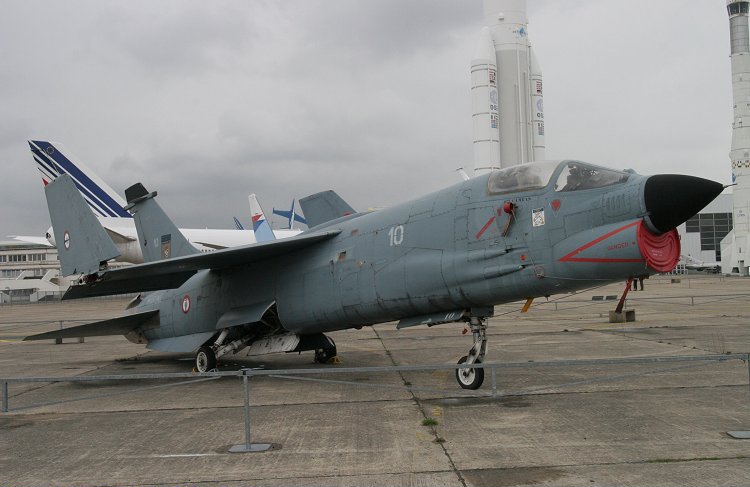
Improved F8FN Crusader of the 1990s in the space and air museum at Le Bourget.
As the Etendard was too small and under-performing for interception it was chosen to seek after a dedicated fighter which in fact replaced the …Vought Corsair. The new interceptor dedicated to the USN was at her time in 1957 the best in its class, capable of Mach 1.8 thanks to a powerful Pratt & Whitney J57-P-20 (47,6 kN). 42 were manufactured for the French Aéronavale, introduced from 1964. They were modified as to be fitted on the smaller French carriers and carried less armament. However they kept excellent performances and had some close encounters during engagements over Yemenite MIG-21s, and Mirages Vs over Lebanon. The only problem was they were discarded from 1999, whereas the USN Crusaders were retired from 1975 and from the reserved in 1987. The planned replacement has never materialized before the long-delayed 4th generation fighter-bomber Dassault Rafale M (Marine). And this goes beyond this topic;
Dassault Super Etendard (1974)
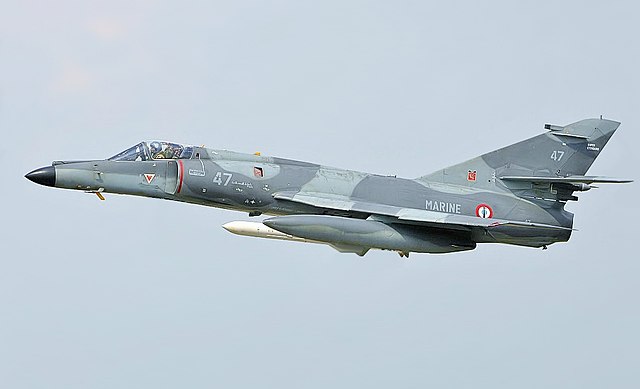
This highly modified and improved version of the Etendard IVM first flew in 1974 and was introduced in the Aéronavale from 1978, replacing all Etendard in service, reclassed on land bases and reserve. The turboreactor Snecma Atar 8K-50 turbojet, was much improved, delivering 49 kN (11,000 lbf) thrust for 1200 kph and a larger payload, and better agility. The best combination happened to be with an extra tank and the Exocet missile, in which the Super-Etendard proved deadly in Argentine service. Not long after, Iraq, then at war with Iran, also acquired it. The Super-Etendard could carry 2,100 kg (4,600 lb), far less than the Rafale however, but it is still complementary and in service can carry the AN-52 free-fall nuclear bomb and later the ASMP missile. These planes are still deployed on the Charles de Gaulle.
Land-based planes
Lockheed P2 Neptune (1945)
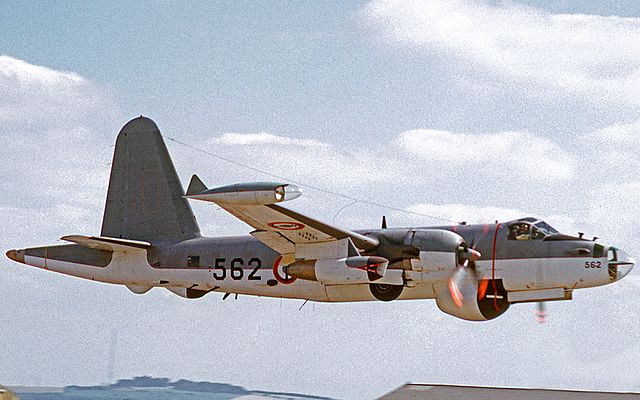
The venerable piston-engine patrol plane became the veteran of the cold war, in use in 11 naval forces around the world. The French Aéronavale adopted it to replace the much smaller Ventura. In France they were deployed from 1960 in the SP-2V6 and 7 versions in Flotille 21F, 22F, 23F, 24F, 25F and 28F. At the beginning it was well armed with eight 12.7 mm HMG positions. The Neptune could carry acoustic buoys, deep charges, and torpedoes. Their main role was ASW cover in the Mediterranean and Atlantic, but the Ile Longue flotilla was to provide an extended cover for operating French SSBNs,chasing possible attack submarines. The Neptune was replaced by the dedicated Atlantique patrol plane.
Breguet Alizé (1954)
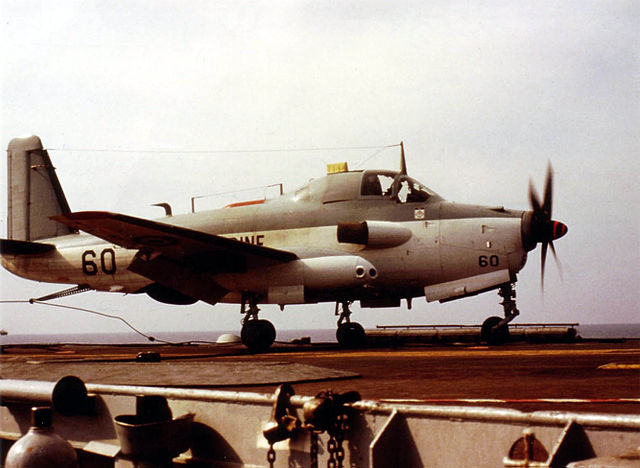
The Bréguet 1050 Alizé was developed from the Vultur prototype, making its first flight in 6 October 1956, operational from 29 May 1959 and retired in the 2000s without replacement (but helicopters). The French Aéronavale and Indian Navy operated the only 82 built. Therefore they saw service on the Arromanches, Clémenceau and Foch, Charles de Gaulle and INS Vikrant. The Alizé is a pure ASW piston-engine, carrier-based patrol plane. It is propelled by the Rolls-Royce RDa.7 Dart Mk 21 turboprop, 1,565 kW (2,099 hp) at 518 km/h (322 mph, 280 kn) and can cover 2,500 km (1,600 mi, 1,300 nmi) or under a flight time of 5 hr 10 min. Like the Skyraider it partly replaced, the Alizé was capable of carrying up to 3 tons payload, including Torpedo or depth charges in the internal bay and Bombs, depth charges, rockets, or missiles underwing pylons.
Breguet Atlantique (1974)
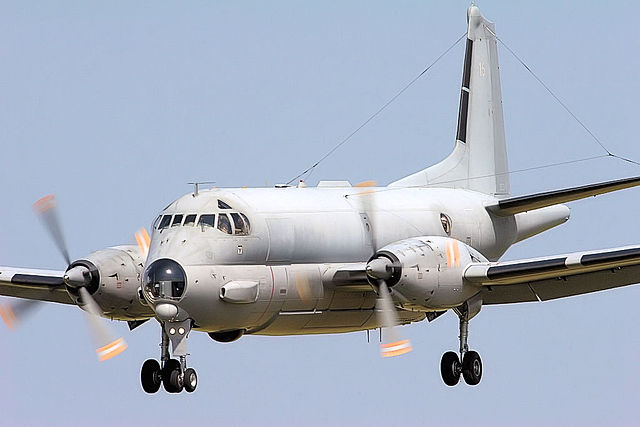
The designated successor of the Neptune was designed even before the Neptune was received, in 1956. The prototype of the future Breguet Br.1150 Atlantic made her first flight in 1961 and was operational from 1965. It was also in a sense the first European dedicated patrol plane, also used by the German Navy (Bundesmarine), Italian Air Force and Royal Netherlands Navy. This long-range (18 hours autonomy) patroller was powered by two Rolls-Royce Tyne RTy.20 Mk 21 2-spool turboprop engines, rated for 4,500 kW (6,100 shp) each. It was capable of 648 km/h but cruised at 314 kph, carrying up to 3,500 kg (7,700 lb) paylod, with torpedoes, depth charges, mines, anti-ship missiles, bombs and/or buoys. The 87 Atlantique 1 started to be completed by 28 Atlantique 2 from 1982-83.
Cold war French projects
France has been frequently plagued in the post war period by budget cuts and delays which frequently hampered the Navy’s plans. The carriers in particular has been in the midst of this. During the Indochina war, the Marine Nationale operated two British (Dixmude and Arromanches) and the US-built ex-Independence class Lafayette and Bois Belleau. They all ensure there was at least two operating groups in operation, but were discarded in the 1960s (1973 for Arromanches). Soon, there were plans to revive the prewar Joffre class aircraft carriers, which construction halted when the war broke out (PA28). The PA58 was a conventional successor to the Clemenceau class (The nuclear-powered Charles de Gaulle was created instead) and the PH75 was an alternative to the Jeanne d’Arc and future Mistral class assault carriers.
PA28 Aircraft Carriers (1947)
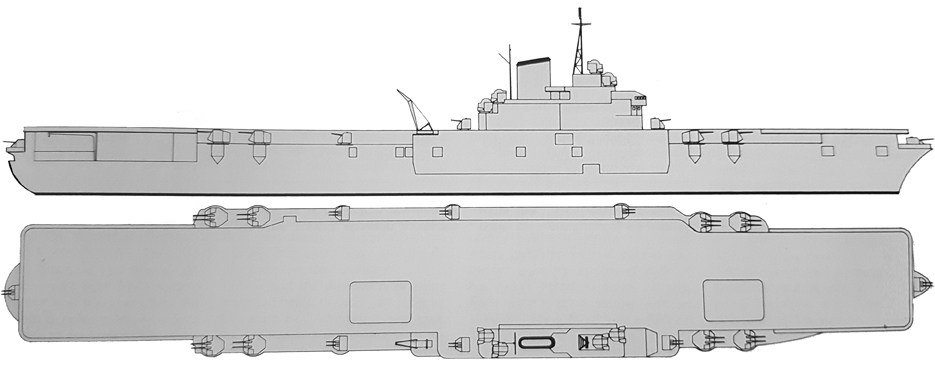
The original Clemenceau was a secret project elaborated on the basis of the Joffre during the occupation, with the idea of building it after the war ended. This culminated in August 1947 when the design was approved and construction ordered. She was to be laid down at Brest. The PA28 borrowed much to wartime British light carrier design. The straight flight deck was armoured, both hangars were offset to port, two lifts 15 x 10 m with a capacity of 12 tons, forward and aft of the island. Seven arrestor hook cables were placed aft, in the classic configuration, with planes flying-off with two catapults and landing on the other side.
The propulsion system was compact and powerful: It consisted of twice the arrangement seen on the super-destroyer Volta, 105,000 hp, enough to reach 32 knots. The AA armament was considerable, with eight twin 100 mm turrets fore and aft and six twin 57 mm (So 24 in all). Aircraft complement was 45: Piston engines Fighters of the Sud-Ouest/SNCASE SE 580 types and the twin-jet TB SNCAC NC1070. The twin 57 mm was a brand new design adopted on all French vessels of the early cold war. However in 1949 the design was already outdated as British recently completed carriers and US upgrades already shown a new path. The PA28 was abandoned in 1950.
Specifications of PA28
Displacement 15,700 – 20,000 tons FL
Dimensions 214 mm pp, 230 mm oa x 25.4m (wl) 36 (Fd) x 6.5 m
Powerplant: 2 shaft Parsons turbines, 4 boilers 105,000 hp 32 knots
Armament: 16 x 100 mm, 16 x 57 mm, 45 aircraft
Complement 1800
PA58 Aircraft Carriers (1958)
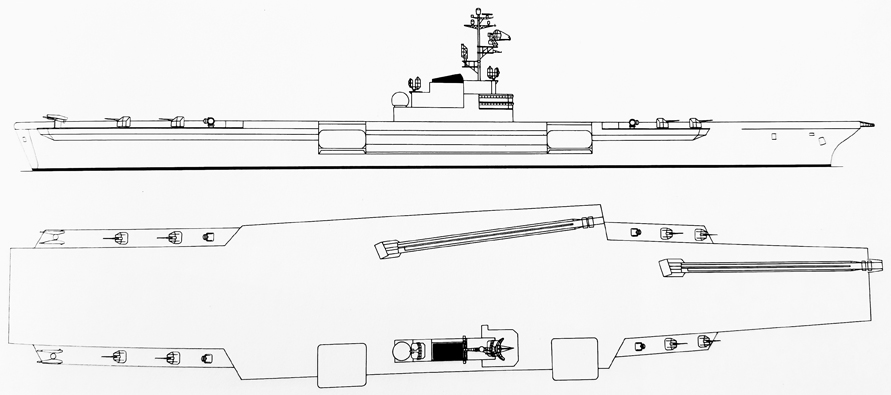
When the 20,000 tons Clemenceau class was approved, the admiralty already planned a much larger carrier specifically to operate nuclear strikes. The project name PA58 was sufficiently advanced at some point for the ship to be named and known as the Verdun. Their construction was considered in 1958 but the program was cancelled in 1961. Apparently, the PA58 alias Verdun was a much larger design compared to the PA54 given its projected displacement of 45,000 tons, inspired by USN Super-carriers of the time, but the length was the same (262 m pp, 286 m wl) whereas the hull’s width was larger at 34 m for a flight deck 58 m wide, quite an improvement.
The PA58 was propelled by Steam turbines on 4 shafts, producing a total of 200,000 shp, for a speed of 33 knots (61 km/h; 38 mph). Parking size inside was much enlarged as well as aicraft handling. The PA58 had two lifts admidships and wo capapults and an angled deck placed the same way as PA54. It was to be armed with two Masurca SAM systems placed at the end of the side sponsons and height standard 100 mm DP guns placed for and aft abaft the flight deck. The placement of these SAMs recalled the American Kitty Hawk class.
The air group would have been largely similar to the Clemenceau to the exception of a navalized version of the heavy Dassault Mirage IVM, which was envisioned. The plane weighted 20 tons which required significant modifications on the lifts and catapults compared to PA54. The air group nevertheless comprised a combination of ASW Alizé aircraft and Etendard fighter-bombers. In 1960 the admiralty saw delays accumulating due to financial problems and eventually envisioned a smaller, cheaper design without the Masurca SAM but it went nowhere and the whole program was discarded and abandoned in 1961.
Later both the Foch and Clemenceau were modified to accommodate the AN52 nuclear bomb. A new “large flight deck” nuclear-powered carrier will emerge in 1990 and take the role of the former abandoned Verdun, the Charles De Gaulle.
Specifications of PA58
Displacement 35,000 – 45,000 tons FL
Dimensions 265 m wl/286 m oa x 34m pp/ 58m oa x 7 m
Powerplant: 4 shaft Parsons turbines, 6 boilers 200,000 hp 33 knots
Armament: 8 x 100 mm, 2 Masurca SAM, 50 aircraft, see notes.
Complement 1800
PH75 Helicopter Carriers (1970)
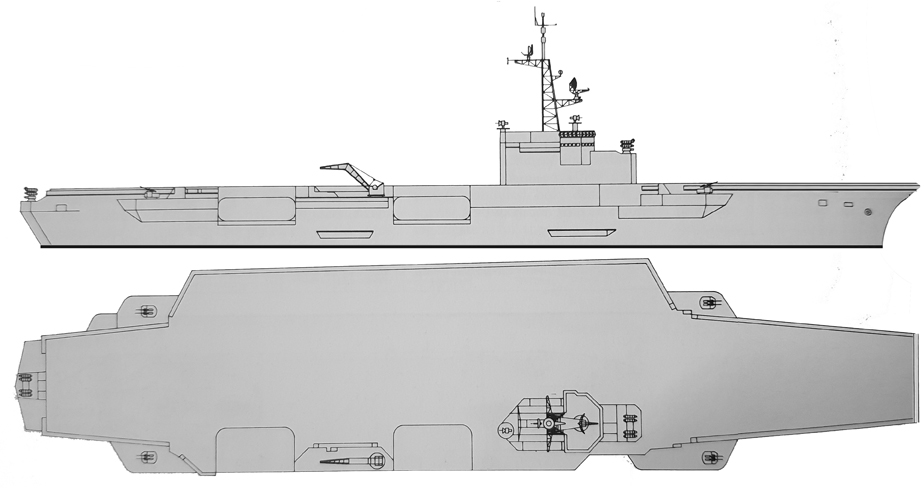
Conway’s profile of the second version PH75
This project was targeted specifically at replacing the Arromanches, arriving at the end of the active career in 1970. Studies for a replacement took into account her last modernization in order to be used as an helicopter career. Several designs were envisioned but in the end one was retained and development proceed from it: The common denominator was the 55,000 shp (for 27 knots) powerplant derived from the F67 class Frigates. The deck was large enough to allow a group up to 25 helicopters of all size and height (from the Alouette III and nimble Gazelle to the heavy-duty Super Frelon), taking off and landing from separate spots at the same time.
Displacement-wise the PA75 displaced around 20-22,000 tons for a 208 m hull lenght reminiscent of the British Invincible class. The beam of the ships was 26.4 m for a deck width of 46 m. Two lifts were placed for and aft of the island. The first two versions incorporated a docking well aft for amphibious operations and accomodated four 26 tons LCMs. The second version, longer but lighter could accomodate two LCMs and two CTMs of 56 tons each. The first could carry 30 tons and the second 90 tons, allowing to land a Marine batallion with light armored cars and medium tanks. The first version flight deck recalled the USN Iwo Jima class, with a rounded edge deck and lifts staggered to port and starboard.
The second version had a broad flight deck, with relocated lifts in the overhang but the island was placed forward. A third variant was developed from the second, but without the docking well. The first two versions had a 90 m hangar, which can house eight Super-Frelon helicopters, and eighteen Westland-Aerospatiale Lynx. Accomodations were provided for 600 men and vehicles. The fourth variant was a smaller ship, 170 m x 25 m without docking well and displacing no more than 15,000 hp. She was however faster at 28 knots. The flight deck was narrow and recalled a scaled-down Clemenceau (PA54). There was a single edge-lift starboard aft of the island. Seven Super-Frelon and sixteen Lynx were carried in all, troop capacity was reduced to 450 men.
In the end, none of these designs was developed further but elements were taken to develop the final PH75 design. It was grossly a retake of the third variant, but nuclear propulsion for unlimited range. Her roles were defined as fleet ASW cover and Amphibious assault. It was programmed also the capability of operations for disaster relief and she was given considerable hospital facilities on three main wards, X-Ray array ward, care ward, infection disease treatment zone, dental surgery and a laboratory. In amphibious operations, the PH75 was supposed to carry a FTI group (Forces Terrestres d’Intervention) and supporting air support unit called CAFI plus helicopter movement command center. Thousand more troops could be accommodated if needed in designated quarters as well as 500 more in the hangar. Outside the helicopters we saw already, Super-Frelon and Lynx for ASW operations, the PH75 normally carried an air wing of troop-carrier Puma helicopters supported by Gazelle attack models.
The final hangar as designed ws 84 m x 21 x 6.5 m high under roof. Both lifts had a 15 tons capacity, there was one fixed crane and extensive helicopter support facilities, workshops, ammunition-handling and management areas, fuel tanks for a total of 1,000 m3 of aviation fuel. The PH75 was also defined as a command ship and possessed a large action communication center, which could be used either for ASW or assault operations. In addition of her own reserve, the ship could also carry 1250 of fuel for accompanying escort ships. Nuclear propulsion gave the advantage of carrying more space for reserve, but the plan was backed-up as customary for other units by an emergency diesel-propulsion unit, giving a range of 3000 nm at 18 knots.
Like other projects born before the petrol crisis of 1979, PH75 program was delayed by financial cuts. At first it should have been started in 1981, but this was pushed later, and the program was renamed PA78, 82, and 88. The change from “Helicopters” to “Aeronefs” meant she was o be provided with VTOL aircraft but this never materialized. It should be noted that at that time on NATO Harriers could have been chosen as the only Dassault’s VTOL was abandoned. In the end, the idea of a nuclear carrier was materialized as the Charles de Gaulle (APN) while more conventional dock assault ships were later designed (Mistral class). The PH75 could be seen indeed quite an overkill for an helicopter carrier as there was no equivalent in the USN.
Specifications of PH75
Displacement 16,400 – 18,400 tons FL
Dimensions 208 m oa x 26.4m /46m oa, x 6.5 m
Powerplant: 2 shaft nuclear, CAS230, 2 Turbo-reduction condenser groups, 65,000 hp 28 knots, 2 AGO emergency diesel.
Armament: 2 Crotale SAM, 2 x 100 mm DP, 2 Sagaie Chaff, 10-25 helicopters, well dock for four Landing crafts, see notes.
Electronics: Radar DRBV 26, DRBV 51, DRBC 32, Sonar DUBA 25.
Complement 800+1000 troops
Plans for 2030 and beyond
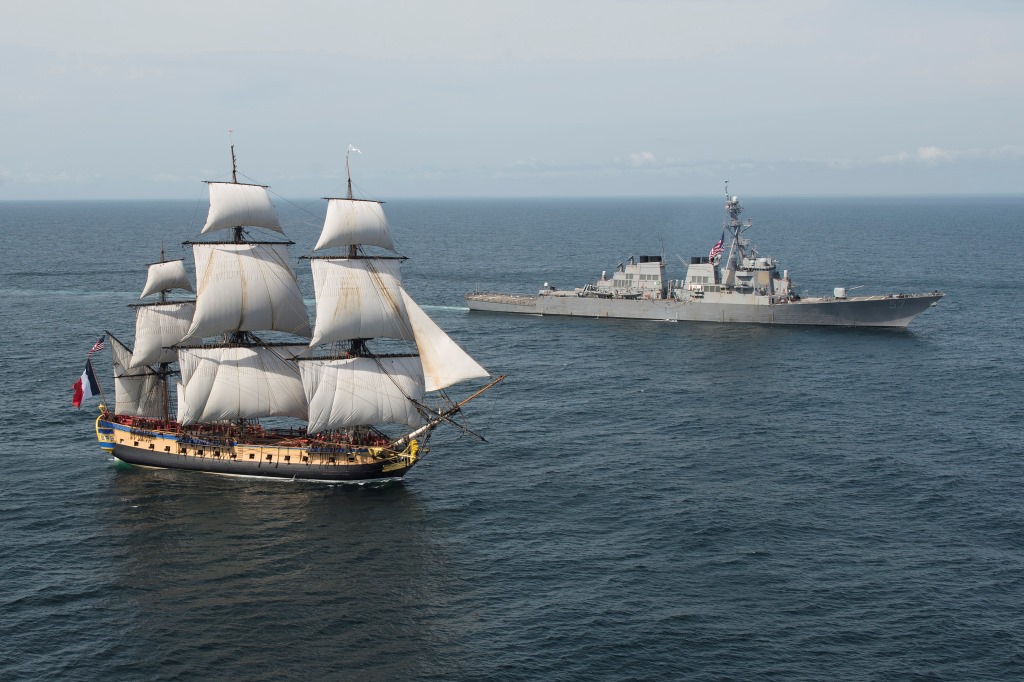
In 2015, France was standing strong of her almost 400 years constituted navy (since 1624) by sending across the Atlantic the Hermione, the replica frigate that carried in 1780 Lafayette and his message to the continental army that the French army was coming. The USS Mitscher (DDG 57), Arleigh-Burke class destroyer, escort her in the vicinity of the Battle of Virginia Capes. USN
Since we will not venture soon into a dedicated modern section encompassing the post-cold war era, from 1990 to 2020, of thirty years, here it is there. That’s a good way to assess the modern French Marine Nationale. With 36,331 personnel as of 2016 and 2800 civilians cooperants serving 180 ships and about the same number of aircraft (including helicopters) (AVIA, the French Naval Aviation), the Marine Nationale’s command structure comprised the ones seen above plus Marine Infantry (FORFUSCO). The latter is not the equivalent of a large “Marine” force like in the US but rather small, highly trained elite units called the Marine Commandos and Naval Fusiliers. More of a Spec Ops unit. Missions however also include security on all Marine sites on land and at sea (on the ships). The structure also calls for traditional units such as the Marins Pompiers (marine firefighters), Gendarmerie Maritime (a coastguard security unit), and the Service de soutien de la Flotte, the fleet supply force.
Home HQs are Brest (Atlantic), as well as the secondary HQs at Cherbourg & Lorient, Toulon (Mediterranean). Overseas HQs concerns Fort de France (Caribbeans), Degrad des Cannes (Fr. Guyana, South America), Port des Galets (La Reunion, Indian Ocean), Dzaoudzi (Mayotte), Nouméa (New Caledonia), Papeete (Tahiti, both in the Pacific) but also Dakar and Djibouti for Africa, West and East. Let’s recall French Maritime Surface EEZ is the world’s second, behind the USA.
Let start with the basics, nomenclature of the actual French Fleet:
-Charles de Gaulle Nuclear AC: In service since 1999, the Charles de Gaulle was the planned replacement of the Clemenceau class, with the difference two ships were planned, not just one. The PAN program started in 1980 but was delayed given the prospect of a joint-venture with Great Britain which also seek a new aircraft carrier of a larger standard than the 1979 Invincible class. The joint British-French project was reported for the second French carrier, but eventually failed over technology transfer concerns, the French mainly sticking to their project of a nuclear carrier and the British to their own conventional one. In the end, the Charles de Gaulle took some time for completion but proved quite a daunting engineering task. After all, this is and remains the only non-US nuclear aircraft carrier within NATO and outside Russia (Kuznetsov) and China (Lianoning).
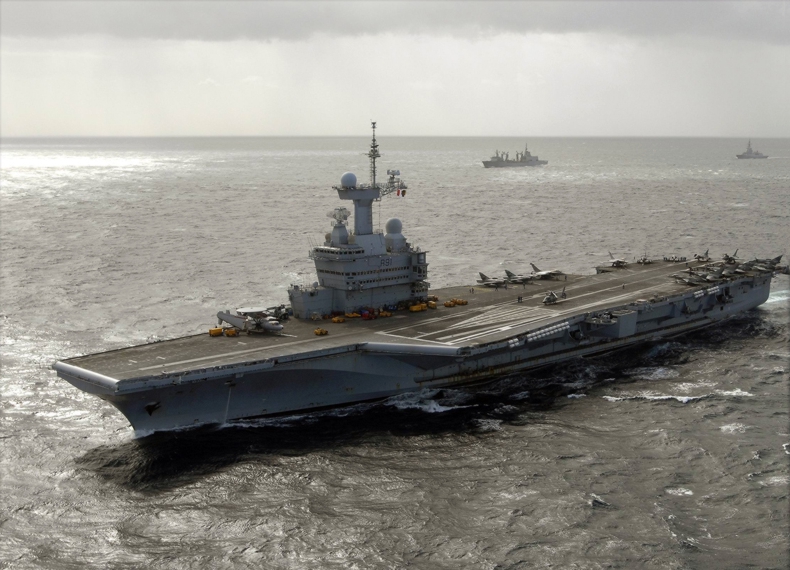
After teething problems the Charles de Gaulle already has served extensively on the international scene for 30 years, going through a major overhaul in the process, but her more crucial problem proved to be the lack of a suitable aircraft, the Rafale program advancing slowly in the meantime. The actual air group of the carrier only comprised the Rafale M as a multirole aicraft and last-generation NH90 helicopters. The conventional PA2 program (now incarnated with the Queen Elisabeth and upcoming Prince of Wales) is now dead in the water and a “sea serpent”, pending budgetary improvements. The problem being the Charles de Gaulle has no backup when in prolongated overhaul. This is somewhat compensated by the three Mistral-class.
The three Mistral-class (BPC) are the French main amphibious assault carriers. The class comprised the Mistral, Tonnerre, and Dixmude. Alongside these, two more were built for Russia but never delivered before the sanctions related to the war in Ukraine. They eventually found a new customer, Egypt. The BPC are dock landing ships and helicopter carriers reminiscent of the PH75 project (see above). They are highly versatile ships, in service since 2006 and 2012 for the last, and way cheaper than the ambitious PH75 with their classic propulsion and civilian grade manufacture (contracted in civilian yards).
Their escort is incarnated by a new generation of ships, 7000 tons Horizon class AA destroyers (Forbin class) of 2005, and the (future) five Aquitaine class ASW destroyers (named after régions like former battleships) of 2010, plus the five older Lafayette class fleet frigates (1992), and five civilian-yard Floréal class patrol frigates (1991). As of today only the Cassard and the two Georges Leygues class remains in service, but until their replacement in 2022-24.
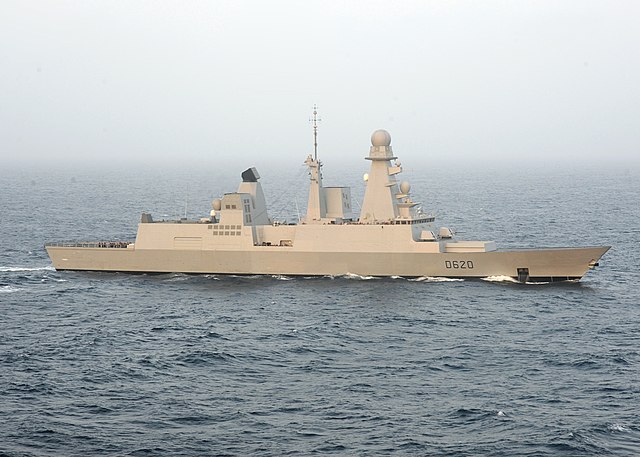
The joint Italian-French Horizon program is one of the last modular destroyer design which is intended to serve until at least 2050.
In addition to this “blue water navy”, the French also operate no less than 15 patrol ships of the D’Entrecasteaux, D’Estienne d’Orves, La Confiance, and L’Audacieuse class. Also 17 mine hunters of the Circé, Vulcain and Antares class, 6 coast guard vessels, the supply vessel Durance, and various specialized ships such as the Monge, Dupuy de Lôme, Alize abd Thetis, three survey ships, two tugs, two support vessels, three training vessels.
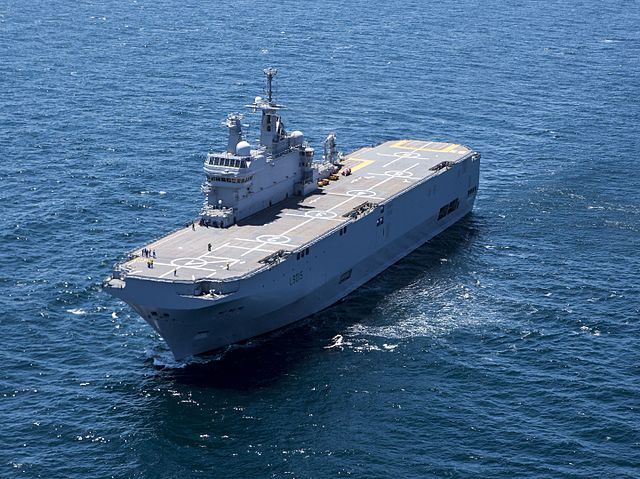
Alongside the Charles de Gaulle, which will remains a single ship, as per budget constraints, there are three BCP of the Mistral class, built with cost savings by using a civilian yard. The key for these ships are versatility. Two others are now in Egyptian service after a constroversial first sale to Russia.
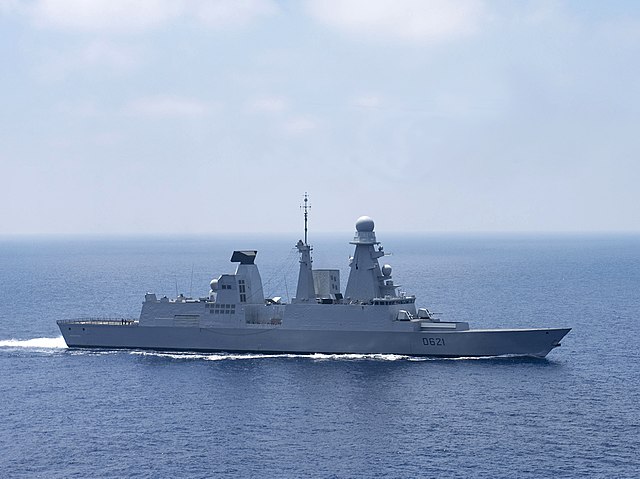
Chevalier Paul, with her sister ship Forbin (2002) one of the two Forbin class vessel, made in partnership with Italy.
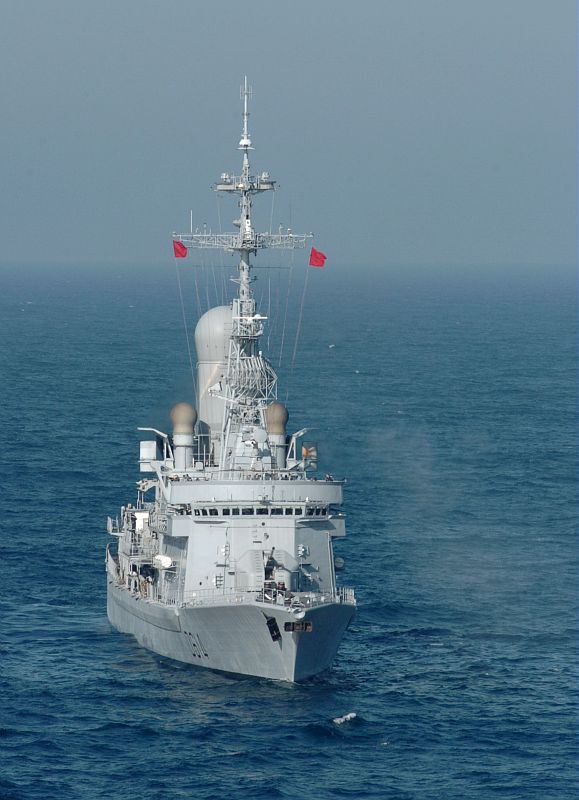
Type 70 CASSARD class AAW Frigate (1982-91). Cassard and Jean Bart are scheduled for replacement by two specialized Aquitaine class vessels in 2025+.
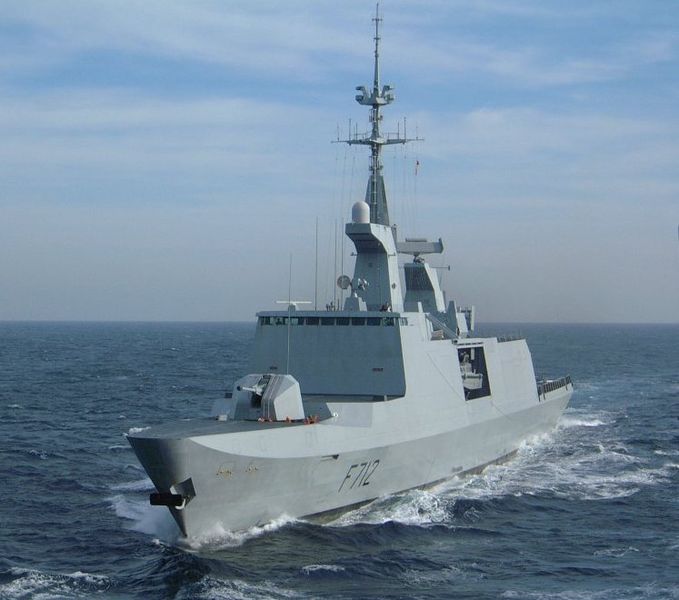
Lafayette class Courbet, multipurpose frigate. Five ships built 1992-99 with advanced stealth characteristics for the time. The older Georges Leygues class (1985) are secheduled for decommission in 2022.
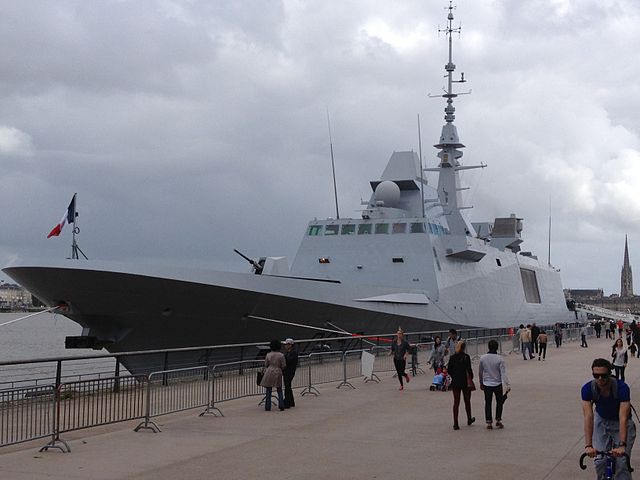
FREMM class frigate Aquitaine, lead ship (8 ships, 2006-2020) ASW and multipurpose.
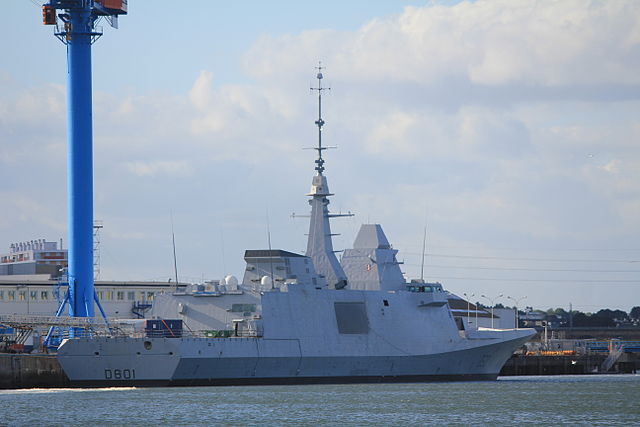
Mohammed VI at Lorient. DCNS also exports the design (Morocco, Egypt) while the Regia Marina planned ten ships (Carlo bergamini class, 2011-2020)
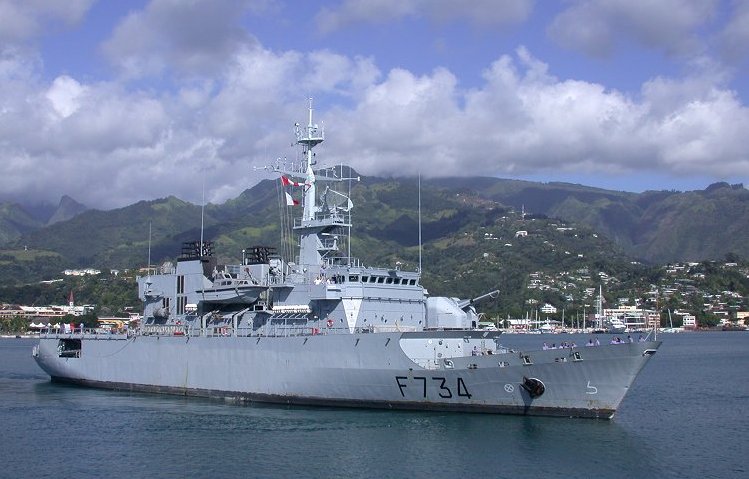
Vendemiaire, of the six Floreal class (1990s). These are second-rate “surveillance frigates” designed to patrol the extensive French EEZ. They had no anti-ship ASW/AAW capabilities and were built on budget using civilian yards.
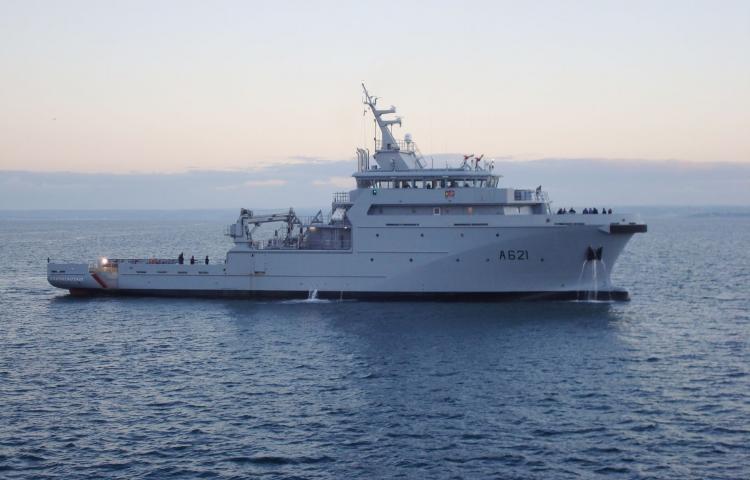
D’Entrecasteaux (2015), one of the four 2300 tonnes Offshore patrol vessel also designed as multi-purpose ships for patrolling the EEZ, notably the Pacific and Indian oceans. Armament is limited to two light MGs.
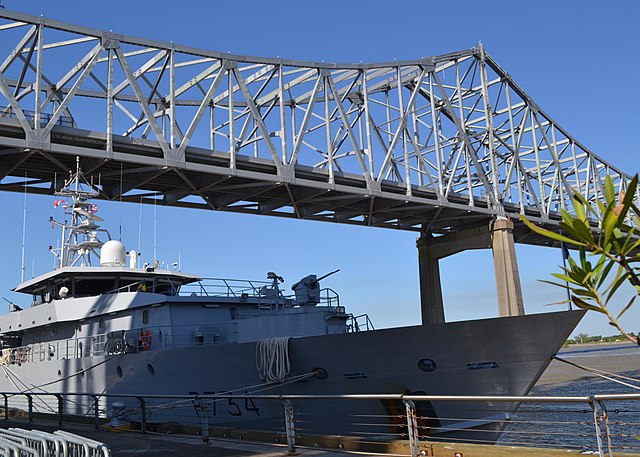
La Resolue, one of the three 700 tonnes OPBs of the La Confiance class (2016)
The French Coast Guard also comprised six ships: Malin, Arago, Fulmar, and the three Flamant, Cormoran and Pluvier of the Flamant class (1995) planned for replacement in 2025.
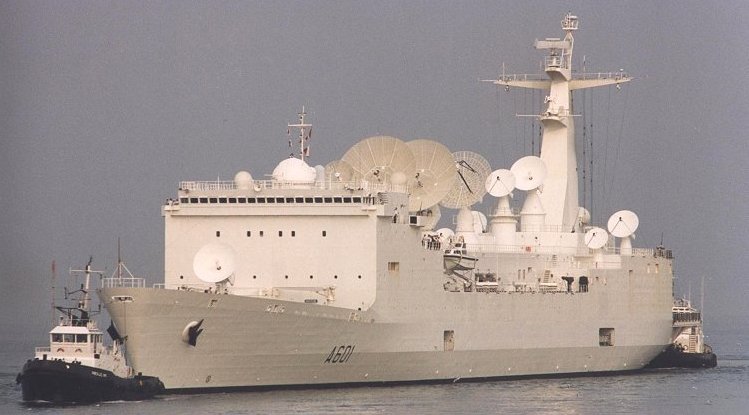
FS Monge, A 21,000 tonnes Tracking ship (1990), one of the largest in the world. She was mainly designed as a missile range instrumentation ship, to track ballistic missile tests, integral to the FOST (French nuclear dissuasion Force).
Another of these specialists of the French Navy is the Dupuy de Lôme (A759) SINGINT (Signals intelligence Ship) of 2005, built in the nertherlands and completed by Thales. There is also the Alizé (A645) of 2004, a diver’s support ship, and the lead ship of the Lapérouse class, Thétis (A785) for Mine-warfare experimentation. Alongside these, the Navy also operates five Oceanographic survey vessels, Beautemps-Beaupré (A758), Pourquoi Pas and three of the Lapérouse class, four oceangoing tugs of the UT507/515 classes, eight vessels of the Argonaute and loire class Support and pollution control and assistance vessels, the eight Léopard class training vessels (1979) for cadets* planned for replacement in 2021, the two Glycine class for navigation training (trawlers type), the UT712/745 class operated under charter and two sailing schooners.
*Cadets can also be trained one of the BPC class ships.
The FOST, the submarine force is eating a great part of the naval budget resources, represented by the five 14,000 tons Triomphant class SSBNs and the five Rubis and improved Amethyste class SSNs, pending replacement by the new Barracuda class SNAs, of which the lead ship, Suffren, has been launched recently in July 2019. Commissioning schedule is expected to stage between 2022 and 2030. The Triomphant class are not expected replacement for before around 2040 (launched 1994-2008).
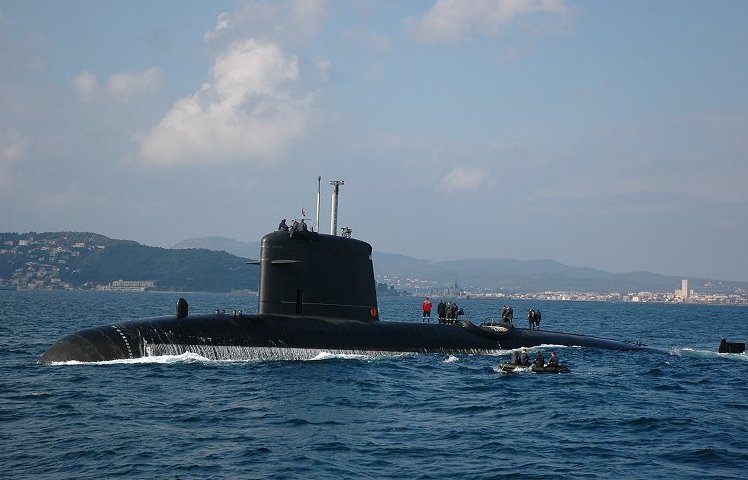
Casabianca, of the Rubis class (now six modernized SSNs), pending replacement by the Barracuda class.
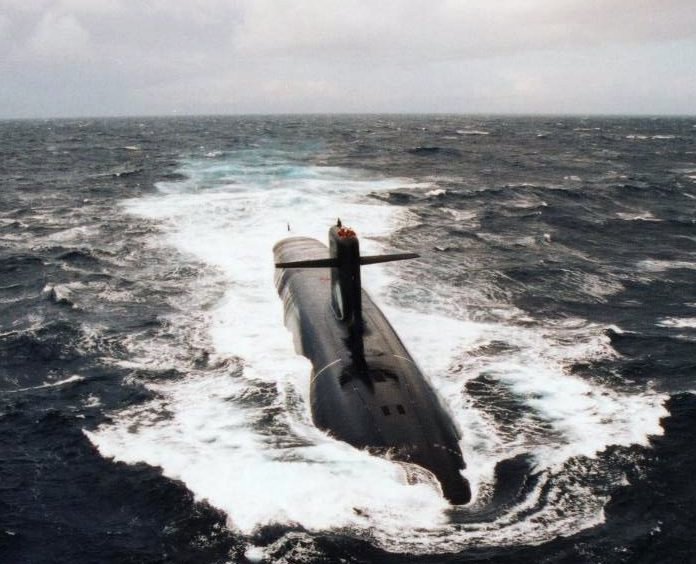
Temeraire, of the Triomphant class (1995) SSBN. No replacement scheduled before 2030 but an upgrade program, notably around the missiles and modular electronics.
So plans until 2030 seems already contained within the current classes we saw, a brand new generation which entered service after the end of the cold war, and quickstarted with the Charles de Gaulle. The FOST is likely to remain unchanged for the next 30 years unless a dramatic international event, the fleet completing acquisition of the Aquitaine class and Barracuda (Suffren) class SNAs. The future ten years of technological advances and innovations could go through the new FTI (or FDI) Frigates developed by Naval Group intended to replace on the long run the 1990 Lafayette class ships. There is no futuristic project showcased recently comparable to the British “dreadnought 2050” but the former DCN “Zumwalt-like” destroyer called the Swordship in 2006.
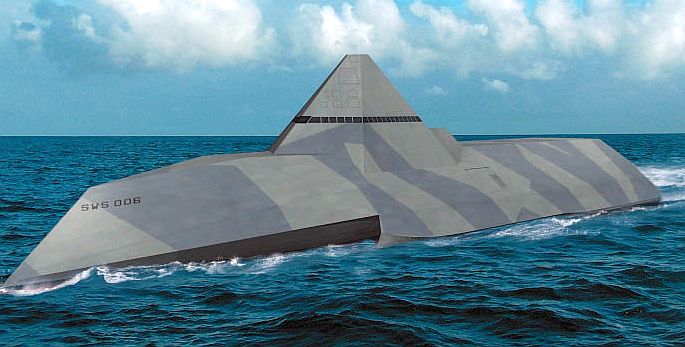
DCN (Now naval group) 2006 Swordship was a futuristic exploration in warship design reminiscent of the Zumwalt style.
Read More/ Src
Conway’s all the world’s fighting ships 1947-95 P.95-132
//www.netmarine.net/bat/tcd/trieux/index.htm
//lefauteuildecolbert.blogspot.com/
//www.defense.gouv.fr/marine
//netmarine.net/f/bat/combatan/
//www.secretprojects.co.uk/threads/verdun-french-aircraft-carrier-images.16711/
//fr.wikipedia.org/wiki/Liste_des_navires_amphibies_fran%C3%A7ais
French Navy archives
//navaltoday.com/tag/french-navy/
//www.militaryfactory.com/modern-navy/french-navy.asp
RSS
//www.seaforces.org/marint/French-Navy/ships.htm
//transportsofdelight.smugmug.com/SHIPS/World-Navies/FRANCE/i-FFLwVH8
Nomenclature of French Cold War Ships
Battleship Jean Bart (1940)
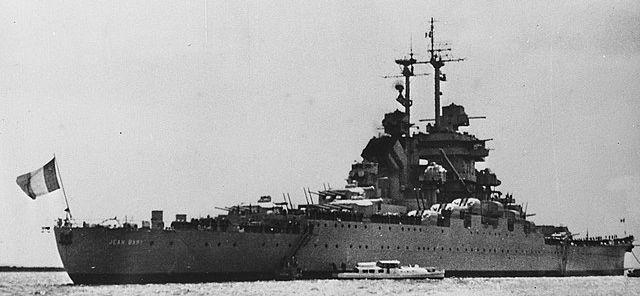
Jean Bart in Suez Canal in 1956. Credits wikimedia commons, Behrens, Herbert/Anefo for a Dutch newspaper.
Siter-ship of the Richelieu, the Jean Bart, named after a XVIIth Century Dunkirk privateer and 8th ship of the name. She was in construction when WW2 broke out, and launched in 6 March 1940. Fitting out Work went around the clock to be ready on time, but in May 1940, not to fight but just prepared to sail out of the harbour and down to North Africa. In June, the outer shaft screws were installed, three aft boilers were fired 12-14 June. Rudder and anchor chains were installed, double bottom was sealed, but she still lacked her armament.
Only the forward A turret received the intended mounts. So in short, Pierre-Jean Ronarc’h managed to sail out the ship on 19 June and at noon she was attacked by three German Heinkel 111 bombers, but survived and made it to Casablanca, towed by tugs along the way. A passing by British destroyer also proposed to tow her to safety to nearby Britain, but the ship was on strict orders. She stayed there until the end of the war, prepared but never completed, exchanging fire at one point with the USS Massachusetts during Operation Torch in November 1942.
After the war ended, there were debate over how to complete her. The days of the classic battleships were out and Admirals Pierre Barjot and Louis Kahn proposed to convert her as an aircraft carrier. Others milited to complete her as a modernized AA battleship and some to scrap her. Kahn (also the director of naval construction) proposed a 40,000 tons CV with 54 planes capacity and defended by no less than sixteen 130 mm (5.1 in) twin AA guns, with a 90mm protected deck. The weak aircraft capacity, obsolescent basis, and cost, make the offer was rejected in the end.
Instead, the AA conversion seemed a better option. Furthermore, battleships could still render some service, both for support and AA cover as shown in the amphibious operations of WW2. In the end, Jean Bart left Casablanca on 25 August 1945 for Cherbourg. She was drydocked at Brest for further repairs, and final completion. The shipyard then started the next phase modernization program revolving around a modern AA, twelve twin 10 mm AA guns while the 130 mm gun turrets were modified to be used as dual-purpose ones.
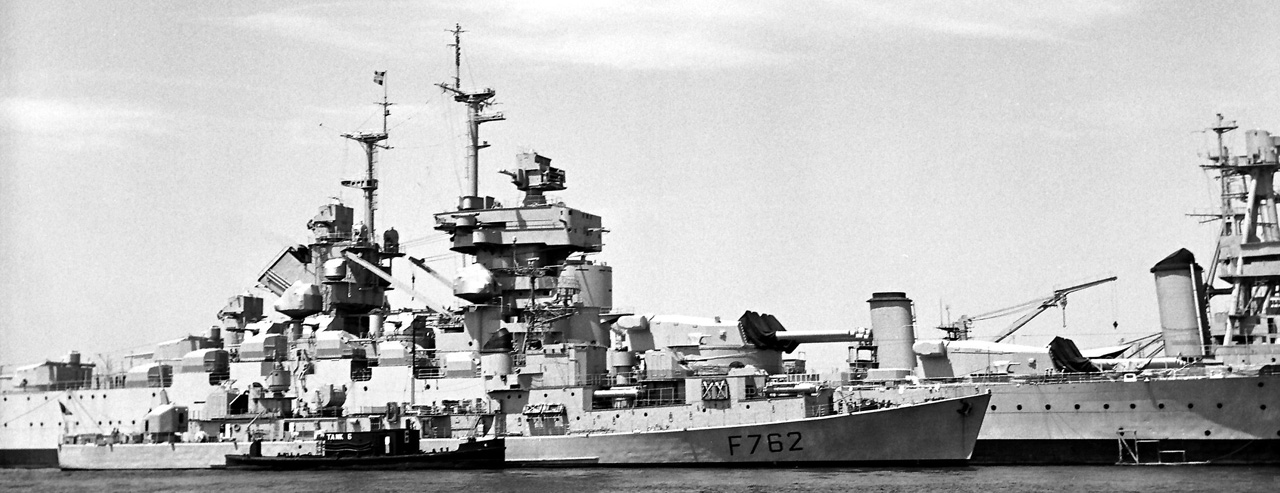
Jean Bart in reserve at Toulon, 1963 (cropped) – Personal photo by Renehaas. Wikimedia CC.
Meanwhile, the main battery turrets were deactivated for preservation. This phase however, completed with tests of new fire directors took years. Albeit Jean Bart has been officially re-commissioned on 8 January 1949, her AA battery was barely operational by 1952. She entered service on 1st May 1955 and between 1951 and 1956 multiplied tests missions at sea to evaluate her armament and fire directors. She received the following electronics:
-DRBV 11 air/surface search radar
-DRBV 20 air search radar
-DRBV 30 navigational radar
-DRBC 10A main battery FCS
-6 ACAE FCS heavy AA
-5 DRBC 30B sets light AA
As built, Jean Bart had a brand new main bridge superstructure instantaneously distinguishable from her sister Richelieu. The latter was discarded in 1956 after an active service in Indochina and returned as training ship. She sailed only once with her sister ship Jean Bart on 30 January 1956 and was scrapped in Italy in 1969. On her side, Jean Bart main active service started with visits to Oslo and independance celebrations in New York (175th anniversary of the landing of French soldiers by Comte de Rochambeau), and made training cruises along the coast of Brittany and the Mediterranean.
With her superfiring turrets reactivated she was deployed from 8 July to Egypt during the Suez Crisis, covering the landing operations of Operation Mousquetaire. The intervention force comprised also the carriers Arromanches and La Fayette, cruiser Georges Leygues, destroyers Surcouf, Kersaint, Cassard, and Bouvet, and the ASW protection group. She shelled Port Said on 5 November 1956.
Next year she served until 19 July 1957 but was placed into reserve, a political choice criticized by the admiralty that estimated the costly modernization efforts has been wasted. In response, they started a study as a missile conversion, creating variants from placing 24–44 missiles launchers on the quarterdeck to reconstructing the forward part of the ship to house a large battery a la Kirov with as many as 325 vectors, ASW, SAM and SSM. Lack of budget forced to study a cheaper alternative, placing an American RIM-2 Terrier missile instead of a 152mm turret. Other prospects tp convert her as a command ship for nuclear testings in the Pacific were dropped she was scrapped in France in 1970. Jean Bart in fact never was fully operational, but she became a testbed for AA artillery and fire control systems useful for the rest of the fleet.

Author’s vector illustration of the Jean Bart in 1956
Specification of the Jean Bart, 1955
Displacement: 37,250 long tons, 43,992 T FL
Dimensions: 247.85 m (813 ft 2 in) x 33.08 m (108 ft 6 in) x 9.9 m (32 ft 6 in)
Powerplant: 4 shaft Parsons geared turbines, 6 Indret Sural boilers 155,000 shp (116,000 kW)
Top Speed: 32 knots (59 km/h; 37 mph)
Range: 9,500 nautical miles (17,600 km; 10,900 mi) at 15 knots
Crew: 1,569
Armament: 8 × 380 mm, 9 × 152 mm DP, 12 × 100 mm AA, 8 × 37 mm AA guns
Armor: Belt: 330 mm, Main deck: 170 mm, Turrets: 430 mm, Conning tower: 340 mm
Aircraft Carrier Dixmude (1945)
This little-known CV made a career successively in the US Navy, then Royal Navy as the escort carrier HMS Biter, built as a C3 standard hull adaptation at Sun Shipbuilding, launched in 1940, converted and commissioned in 1942, transferred to France in 1945. She saw service in Indochina in 1947, operating Dauntless SBDs and in 1949 was relegated as aircraft transport until 1960. She replaced the Jules Verne as base ship for the amphibious Forces at St Mandrier and was returned to the US in 1966 and sank as target afterwards.
Aircraft Carrier Arromanches (1945)
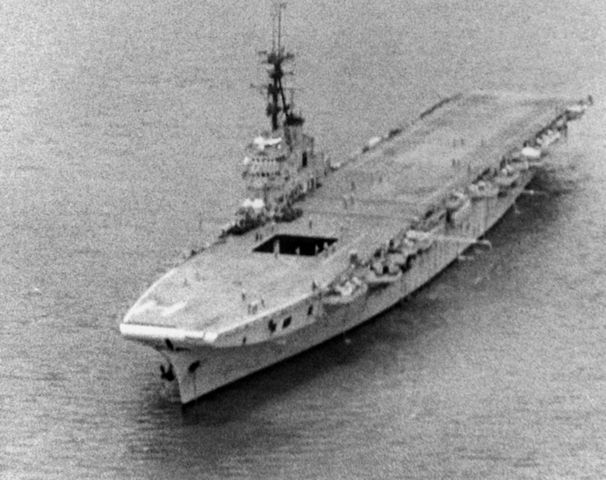
Arromanches (R95) off Da Nang, Indochina, 1954
The Vickers-Armstrong HMS Colossus, lead ship of the same name class British aicraft carrier. She was launched on September 30, 1943 and commissioned in December 1944 for the Royal Navy and served until 1946. She was transferred to France over a five years loan the same year. She was finally bought in 1951.

Arromanches with a F6F-5 Hellcat landing circa 1953 in the Tonkin Gulf – U.S. Navy National Museum of Naval Aviation
She had received little modifications and served in Indochina flying SBD dauntless dive bombers and Seafire Mk.XV fighter-bombers. During her next campaign she flew Helldivers ad Hellcats. She would return for two more campaigns. Back home after the disaster of Dien Bien phu in 1954, she also operated in the Mediterranean and took part in the Suez operations in 1956, flying Corsairs and Avengers. She was modernized in 1957-58, with a 4° angled flying deck, axial runway and mirror landing sight, whereas the single catapult was removed as well as the WW2 AA armament.
She received a DRBV-22A air surveillance radar. She served afterwards as a training carrier, for future airmen of the first French Carriers of the Clemenceau class. In 1959 she operated the Alizé ASW aircraft and Fouga CM175M Zephyr, naval training jet, and from 1962 she carried HSS-1 helicopters for assault role. In 1968 she was modernized again, mostly revolving around new electronics and became an helicopter carrier, both for amphibious assaults and ASW battle force escort. She was also used as fast transport and training and was withdrawn in 1974 and scrapped in 1978.
Photo Flickr
(colorized from M. bar coll.) http://www.ffaa.net/ships/aircraft-carrier/arromanches/arromanches.htm. Casting off from NS Toulon, bound for Indochina.
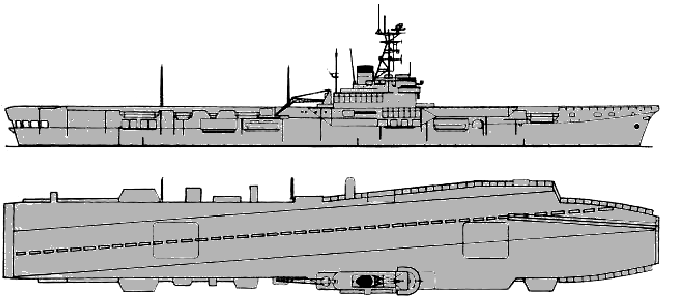
Arromanches in 1971 – Conway’s profile.
SPECIFICATIONS
Displacement: 14 000 t, 17 900 t FL
Dimensions: 693. 77 ft (length) x 118. 11 ft (width) or 211. 25 m x 36 m
Range: 12 000 nm @ 14 kts – 12 000 nm @ 14 kts
Top Speed: 25 knots
Powerplant: 4 shaft Parsons turbines, 4 boilers 40 000 hp (29 840 kW)
Initial armament: 24 x 2 pdr ‘Pom-Pom’, 14 x 40 mm bofors.
Flight deck of 211 x 24. 50 m, catapult, two lifts (13. 72 x 10. 36 m), hangar (104. 24 x 15. 85 m).
Flight 1950s 13 TBMs, 2 HUP-2s or 15 F4Us and 2 HUP-2.
24 aircraft or about 30 helicopters.
Lafayette class Aircraft Carriers (1950)
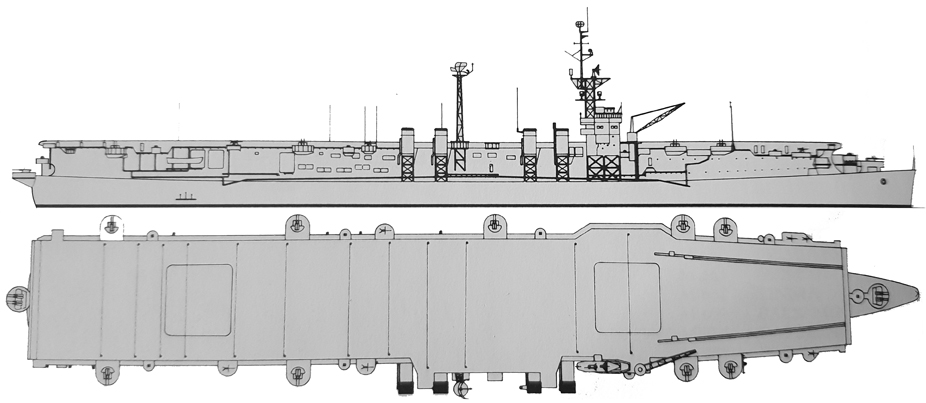
Lafayette in 1959. Since 1945 she has been modernized, electronics-wise.
In 1950 under MDAP, France received the former USS langley, of the Independence class. She was renamed Lafayette and was pressed into service with a complement of USN aviation in Indochina. In 1953 a second carrier of the same class was obtained, Belleau Woods. In French service she was recommissioned as ‘Bois Belleau’ (the same in French) to honor the memory of US soldiers fallen for France here. Contrary to the first she was obtained through a five years loan. Both ships were too small for jets and only operated a park of former USN piston-engine Hellcats, Helldiver and Avengers purchased from 1950 to 1953 with US financial help. This was in general the result of a larger support to the French fight in Indochina, seen as fighting and containing communist insurgents rather than trying to restore their colonial rule in the region.
Lafayette served actively in Indochina until 1953, the proximity of the coast and narrow inlands making it easy for aviation to strike everywhere. She was relieved by Bois Belleau which saw the end of the war. After peace was signed, both ships returned home for a refit. The catapults were modernized and a tall lattice mast added forward of the port aft funnel pair, to support a modern radar DRBV 22A. In 1958 during the second refit, a DRBI 10 height finder found its placed on the main mast above the bridge. A that time both ships operated almost only Vough Corsairs. They were based in Toulon and participated in fleet exercises, and were soon involved in the Algerian war. In 1956 however Lafayette was deployed at Suez for the Franco-British intervention. In 1960 Bois Belleau was used as an aircraft transport to the US and was returned to the USN to be placed in reserved this year, joined by Lafayette in 1963. Both were scrapped afterwards.
Clemenceau class Aircraft Carriers (1957)
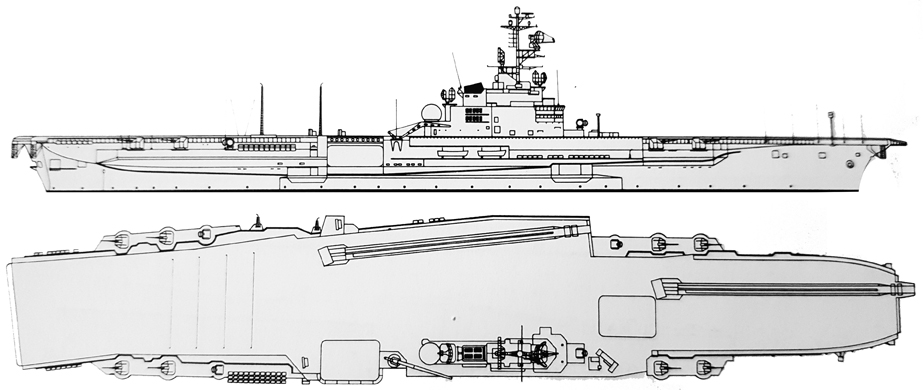
After the Joffre class, never completed because of the war, the Clemenceau class was the first French aircraft carriers to be built from the keel up. There was a lot of experience already and good design examples with the Arromanches and Lafayette class to draw with, but the genesis of the type came back with the PA28, designed immediately postwar in 1947. The design was dropped as obsolete in 1950. To ensure French independance at sea it was chosen to develop another design of 35,000 tons, inspired by the much larger British Audacious class (42,000 tons).
However it was rejected as too costly, while a larger US-inspired fleet carrier to carry nuclear strikes was studied instead (PA58). There was a return to the General Staff 1949’s plans for four aircraft carriers of 20,000 tons. After 1955, 20,000 tons seemed weak to operate jets but plans included a revised design made available for NATO contribution according to the Lisbon protocol. Eventually, the 20,000 tons PA 54 Clemenceau was budgeted in 1953, but delayed until November 1955. It was to be followed by the Foch. Because of many more delays about their replacement their career was quite long, until 1998 and 2000. By that time, their limited flying decks made them obsolete.
Their conventional CATOBAR design was looking more at modernized Essex-class carriers (with similar dimensions and tonnage) than the British Audacious class. This limited the types of airplanes they could operate: The nimble Etendard and later Super-Etendard and the American F8 Crusader, which was obsolete but without replacement in the 1980s. As multi-role fleet carriers, their first air group comprised 10 Dassault Étendard IV strike fighter and 10 IVP, the reconnaissance version.
The main fighter then was the SE Aquilon (De Havilland Sea Venom under licence), replaced later by the Crusaders in 1963. ASW warfare was assumed by eight Breguet Alizé piston-engine planes, and four multirole Alouette III helicopters. In amphibious attack role, they were able to operated 30–40 helicopters. In 1978 the Super-Etendard bring a much needed upgrade as the multirole naval jet of the Marine Nationale. It was able to operate the ASMP missile (nuclear). This came at the same time of a much-needed modernization and overhaul in 1977-1980. The Foch was sold to Brazil and served as São Paulo until 2017, rearmed with 5 × 12.7 mm machine guns in addition.
SPECIFICATIONS
Displacement: 20,000 t, 32 780 t FL
Dimensions: 265 x 51.2 x 8.6 m
Powerplant: 4 steam turbines, 6 boilers, 126,000 hp
Top Speed: 32 knots (59 kph) range 7500 np
Armament: 8 × 100mm (1980: Four dual Simbad SAM launchers).
Flight deck of 165.5 m (543 ft) long by 29.5 m (97 ft) wide, 2 catapults, two lifts, 8° axis angled deck.
Flight 1960 see notes. 1980: 20 Super-Etendard, 16 F8fn Crusader, 4 Alouette Helicopters, 8 Breguet Alize.
Chateaurenault class cruisers (1948)

The ex-Attilio Regolo class cruisers built during WW2 were attributed to France in 1948. They were recent and had been seldom used, and in pristine conditions but their design was outdated and their role needed to be redefined. It was decided to convert them as rapid ASW/AA escort cruisers. Conversion started after some design work and development in 1951 at La Seyne Dockyard. Conversion lasted until 1954 and when re-commissioned as Chateaurenault and Guichen, former Scipio Africano and Attilio Regolo. Their new nomenclature was “escorteur d’escadre” (litt. squadron escort) just like the T47 destroyers. Ther original armament was entirely deposed, and a brand new one mounted. Superstructure and the bridge were alterered, new masts and electronics installed.
The Chateurenault class was given three twin 105 mm mounts -the same type mounted on the Bismarck, Scharnhorst and other German capital ships and cruisers. Two were mounted aft in a superfiring pair, and one on a supestructure forward. It was completed by five French-pattern twin 57 mm pattern 1951, one in “B” position at the front, just behind the forward 105 mm mount. The four others were placed behind the rear funnel behind the fire directors on the aft deckhouse. The main director was placed on the bridge. In complement for ASW warfare, four triple 550 mm TTs were installed at the front, abaft the forward superstructure, upper deck level on the bridge. A short lattice mast carried the DRBV11 surface radar a,d DRBV 20A aerial surveillance radar.
Since they were larger than the new T47 and T53 class destroyers they acted as command ships for squadrons, a bit like the former flotilla leaders. But to fulfill this role, it ws decided early on to remove their aft deck 105 mm mount and later to remove two TT banks, just to provide estra accomodation. Their service nevertheless was relatively short, ending in 1961-61. They were both stricken and scrapped afterwards.
SPECIFICATIONS
Displacement: 3,680 t, 5,500 t FL
Dimensions: 138.7/142.2m x 14.4m x 4.1 m
Powerplant: 2 shaft Belluzzo geared steam turbines, 4 boilers, 110,000 hp
Top Speed: 39 knots (? kph) range 3600 nm at 18 knots
Armament: 6 × 105 mm (3×2), 10 x 57 mm mod 1951 (5×2) 12 x 550 mm TT (4×3)
Sensors: Radars DBRV 20A, DRBV/DRBC 11, two DRBC 30
Crew: 343
Cruiser De Grasse (1946)

De Grasse was in a sense the last prewar French cruiser. She was indeed laid down in November 1936 at arsenal de Lorient, as a conventional light cruiser with a triple 152 mm guns arrangement (nine-nine in). It mirrored the St Louis class for heavy cruisers, and the added size meant she was to be more heavily armed on the AA side, and carry three reconnaissance planes. Work stalled in September 1939 and stopped completely in 1940, short of workforce. Vichy French admiralty had the same problems and already struggling for the maintenance of existing ships in service, so nothing happened before the end of the war and month after. The two other ships, to be named Châteaurenault (F C de la Méditerranée, La Seyne) and Guichen (F C de la Gironde, Bordeaux), were cancelled before their keels were laid down.
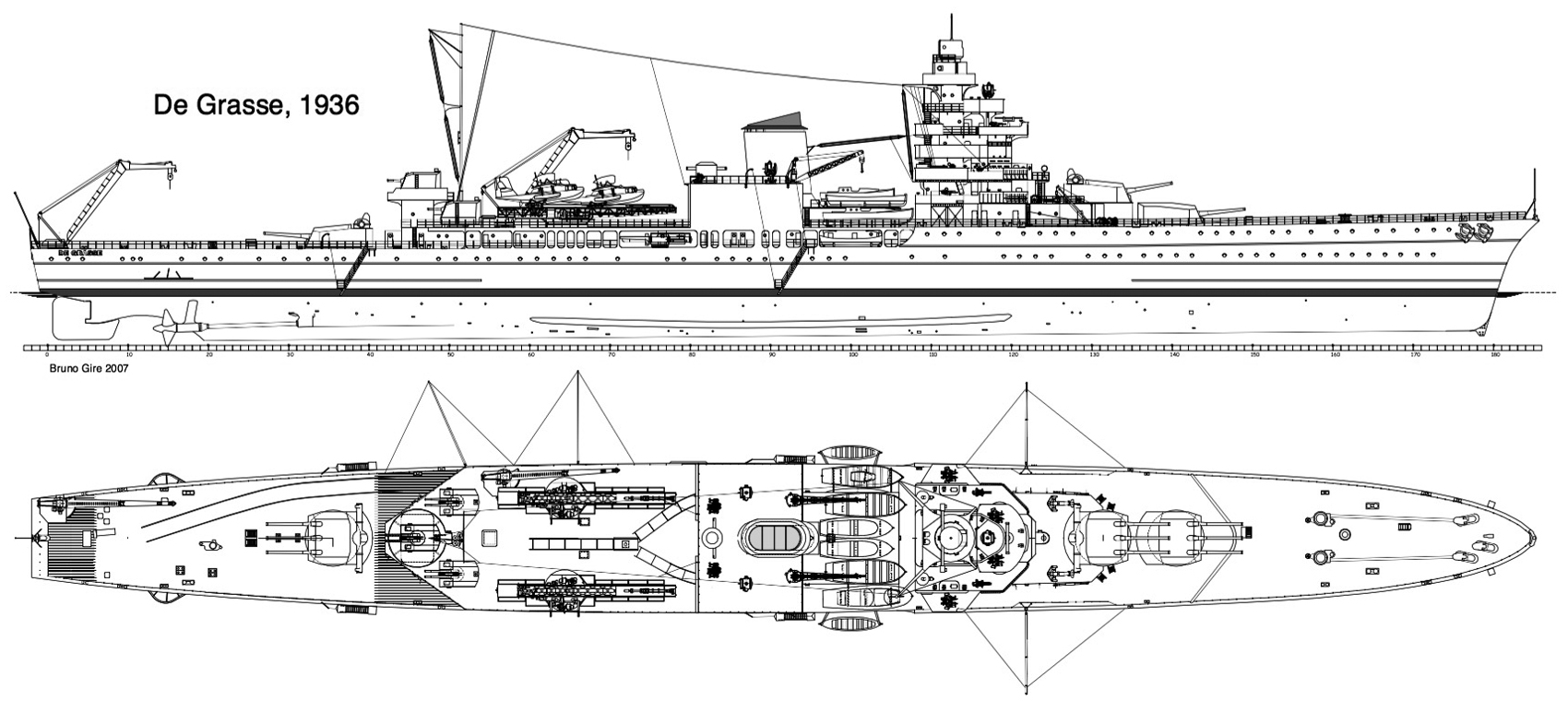
HD reconstruction from original blueprints of the De Grasse class, as designed in 1936.
It was reassessed the practicity of completing the hull at that time, at least to replace war losses. However there was no clear consensus over the design. The hull was eventually completed in 1946, and it was decided at some point to complete her as a modernized AA cruiser. Design therefore stopped again to create a brand new design, and the process lasted until 1951. In January, completion work started. At some point however because of human error, the drydock was filled while the ship still had its sea-cocks open. The hull filled rapidly and sank to the bottom of the dock. She was refloated and the modernization procress restarted.
There was a whole range of modifications attempted as testified by the different between the top profile (as completed in 1956) and the 1936 design below. The armament was a sure choice: The new 127 mm dual purpose automated twin mounts model 1948 would constitute the main artillery, and in total eight were provided and twenty twin 57 mm mounts of the 1951 pattern. There was nothing else, like torpedo banks, despite the fact original plans called for two triple 550 mm banks, they were dropped from the final plans. A true AA cruiser, with an extensive electronics and fire control array and some facilities for command and control. The armament was the same as found on the new T47 destroyers, therefore authorized a lead role.
The eight twin 127 mm (5 in) were placed in lozenge arrangements, with forward and aft guns in tandem, the B and Y position slightly surelevated on their barbettes, and the next two either side of the forward upper deck and aft deck. On secondary upper deck were placed the lighter twin 57 mm mounts, four aft, two tandem pairs either side of the rear fire directors, and three forward, one either side of the main bridge and one surelevated on an upper deck extending the bridge. The 5-in were served by two main directors placed on the main bridge and aft position, completed by four secondary directors either side of the bridge and aft. The electronics suite comprised a DRBV 20A surface surveillance radar, a DRBV 11, DRBI 10, four DRBC 11 and four DRBC 30. All guns were fully stabilized with gun-layers and radar-controlled tracking.
Another interesting aspect of the design was its command structure, with coordination of air defence with other ships in the area, and capability to direct air strikes in an assault operation. This task in particular was well managed by the DRBI 10 height-finding radar. Powerplant-side, there was no significant progress in the design. The original configuration was kept, which ease design work and completion. The ship kept a truncated arrangement of exhaust into one single funnel. The two Rateau-Bretagne steam turbines planned were still efficient in 1950 and provided 110,000 hp. Since armour was absent of kept minimal, top speed was a comfortable 33 knots. However the transom stern was redesigned but despite some savings, the final design was 1400 tons heavier than planned.
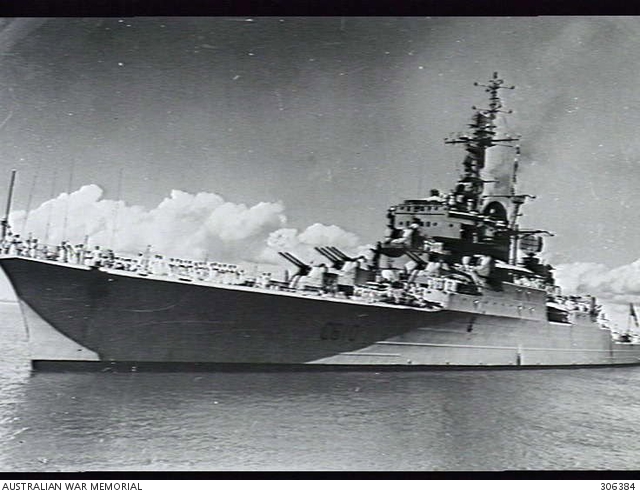
De Grasse before 1966, in a visit in the pacific, Australian War Museum coll.
In service, the De Grasse (from the famous admiral De Grasse whole played a crucial role in the American revolution) served with the French blue water fleet as an escort vessel, but it happened her AA was perhaps a bit too optimistic: The four innermost 57 mm mountings and their respective fire directors were inneficient and deposed in 1961. At the same time she received the new DRBV 20A radar. In 1966, De Grasse underwent a major reconstruction. Her AA role was now taken over by lighter ship so it was decided to equip her for the Pacific experimental centre in Tahiti, as flagship and command ship. She received an extended signals department, while a tall lattice mast was raised aft, supporting antennae and communication array for large distance communication.
Added to this, the aft 5-in mounts were removed and all 57 mm mounts as well as all directors but the main forward one, above the bridge. The former search radars were replaced by a single DRBV 23. There was also a significant effort to protect the ship for radiation fallout, which was related to the nuclear tests practiced there. Displacement fell to 9,000 tons and complement to 500 in order to accomodate the extra 120 engineers and technicians of the Mururoa test team. De Grasse became de facto the “atomic command ship” of the French Navy, until 1973 when she made it home to be stricken and scrapped in 1976.
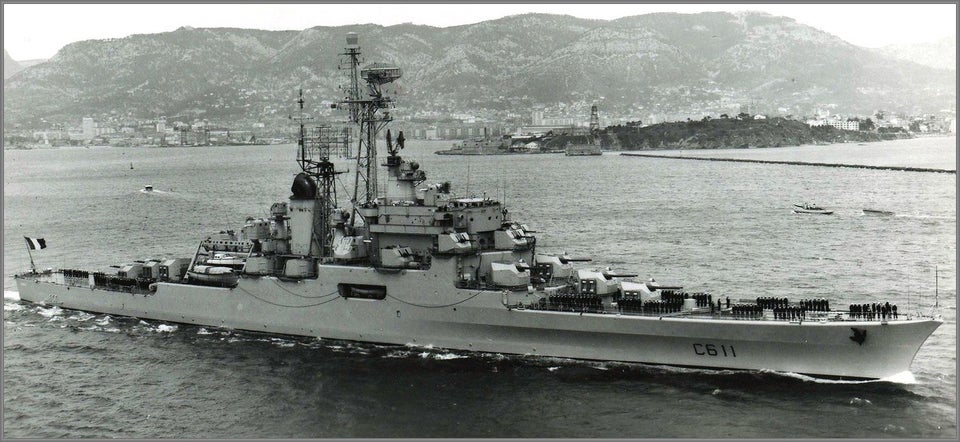
De Grasse as built, unknown origin, from reddit.
SPECIFICATIONS
Displacement: 9,380 t, 11,545 t FL
Dimensions: 180.5/188.3m x 16.6m x 5.5 m
Powerplant: 2 Rateau geared steam turbines, 4 boilers, 110,000 hp
Top Speed: 33 knots (? kph) range ? nm at 18 knots
Armament: 16 × 127 mm (8×2), 20 x 57 mm mod 1951 (10×2).
Sensors: Radars DBRV 20A, DRBV/DRBC 11, DRBI 10, DRBC 30
Crew: 950, 983 as flagship or 500+120 as pacific command ship (1966)
Cruiser Colbert (1956)

Colbert as a missile cruiser (Conway’s)
The Colbert was developed from the De Grasse but included a number of modifications, like a shortened transom stern, beam increase, a knuckle in the hull forward, a new deck protection reaching 50 mm and horizontal (belt) from 50 to 80 mm. Her initial armament was similar to the De Grasse, as an AA fleet escort: Eight twin 127 mm (5 in) M1948 and ten twin 57 mm (2.2 in) M1951. The elctronics suite comprised a DRBV 20A, 22A, DRBI 10, four fire direction radars DRBC 31B, four DRBC 31A and a sonar DSBV 1. The powerplant installation was less powerful than for the De Grasse: Two shaft were connected to CEM Parsons geared steam turbines, fed by four higher pressure boilers for a total of 87,000 hp. This allowed a top speed of 33 knots however, like the De Grasse. Range was 4000 nautical miles at cruise speed of 25 knots. Displacement was therefore less important, 11,100 tons fully loaded instead of 11,545.
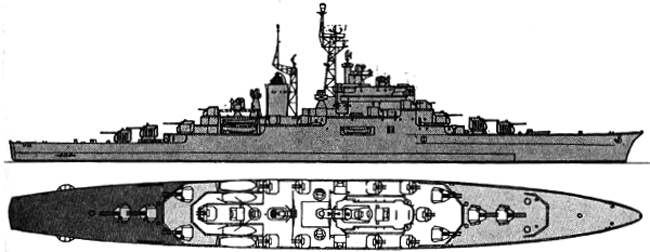
The Colbert in her initial state before reconstruction as a missile cruisers in 1959 (credits: Navypedia).
Colbert was laid down at Arsenal de Brest in December 1953, launched in March 1956 and completed in May 1959. She was fitted like the De Grasse as a command ship. Their superstructure differed, the Colbert notably had two lattice masts which took place between the bridge and the funnel which was moved further aft. The hull was taller and more stepped. The Colbert was also fitted for troop transport, with accomodation for 2,400 men and their equipments. An helicopter pad was created at the stern. The fire controls systems were the same as on the De Grasse. Plans however showed an additional pair of 57 mm guns at the stern, not mounted. However at the difference of De Grasse, provision was made for a future missile conversion. She was completed provisionally with the old DBRV 20A radar as the planned 20C was yet not ready. The swap was made with her 1963 refit.

In 1970 both cruisers were recbuilt. De Grasse, as seen above was coverted as a base ship for the nuclear tests at Mururoa in the Pacific. Meanwhile, Colbert was rebuilt as a missile cruiser. The refit started in April 1970 and lasted until October 1972. The initial plans included the removal of all AA guns, but budget reduction prevented the move and part of the initial armament was kept. However she was equipped as planned with a Masurca SAM at the stern, with reloads and dedicated DRBC 51 tracker illuminators, one for each missile. The initial plans included six of the new dual purpose automatic 100 mm guns, with four placed on the sides, but for budget savings only two were fitted at the front.
They were coupled with a DRBC 32C fire control director. Two DRBC 31 fire control directors were also kept for the remaining 57 mm guns. Also forward of the bridge bedplates were installed for Exocet missile MM38 SSM containers, eight total. Also the bridge structure was totally rebuilt, and three lattice masts fitted to support massive new aerials. The new set comprised a DRBV 20, DRBV 32 C, DRBV 50, DRBI 10, two DRBI 51, DRBC 32C and two DRBC 31. To serve this powerful electronic ensemble, electrical power was multiplied, increasd to 5000 kw while air conditioning was provided in all the ship and complement reduced to 560, while accomodations were revised. This was still a spacious ship. The next modenrization included the installation of a Masurca Mk2 Mod 2 SAM and later Mod 3 which replaced the beam type guidance by a semi-active homer.
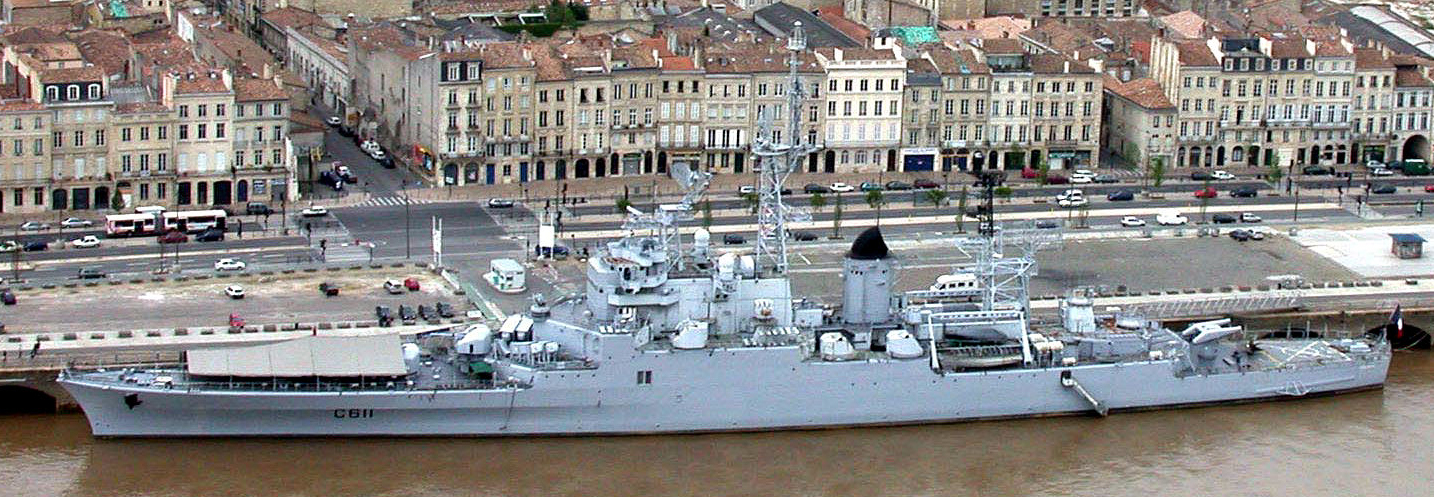
The Colbert in Bordeaux as a museum ship. She never was a touristic attraction like the HMS Belfast in London.
There were also plans to add a short-range Crotale set, never implemented. A SENIT 1 central operation information system was installed and as Syracuse satcom system in 1982, making the Colbert the director ship for fleet defense. Colbert was the flagship of the Mediterranean fleet until she was discarded in 1991. She became a museum ship at Bordeaux, the last French cruiser. However this secondary career was compromised both by local opposition to its presence and operating cost, the private association never been able to maintain her. Eventually she closed in 2006 as a museum and was towed to the mothball fleet in Landevennec. She was cannibalized to maintain the Jeanne d’Arc and later was sold for scrap, decontaminated prior to scrapping in August 2017 and scrapped in Gironde.
SPECIFICATIONS (1972)
Displacement: 9,085 t, 11,100 t FL
Dimensions: 180.5/187m x 20.3m x 6.5 m
Powerplant: 2 CEM Parsons geared steam turbines, 4 boilers, 877,000 hp
Top Speed: 33 knots (? kph) range ? nm at 18 knots
Armament: 1×2 Masurca SAM, 4 MM38 Exocet SSM, 2 × 100 mm DP, 8 x 57 mm mod 1951 (4×2).
Sensors: See notes
Crew: 560
Jeanne D’Arc Helicopter Cruiser (1961)
The R97 was the sixth French ship of the same name (and possibly the last). Previous occurrences were Frigates, and armoured corvette, and two cruisers. The last cruiser of the name was a training cruiser, which joined the Free French and was discarded in 1964, when the new ship was just commissioned. The new Jeanne d’Arc was laid down in 1959, and launched in 1961. The armament consisted in two 100 mm standard turrets on the bridge, flanked by two triple banks of MM38 antiship missiles. The aft part of the ship was the flight deck, complete with an aft elevator, a configuration recalling the Soviet Moskva type.
Electronics-wise, her array comprised surface radars DRBV-22, DRBV-51, 2 Racal Decca DRBN-34 radars, 3 aerial DRBC-32 A, a DUBV-24 sonar, an ARBR-16 warning, one interception radar ARBX-10, an ASW noise dispenser SLQ-25 Nixie, TACAN NRBP-20 and NRBI-50 IFF system.
During the short interim before the old cruiser was discarded she was called La Résolue. The difference with the old cruiser was her dual role, of instruction and training in peacetime, and multipurpose helicopter platform in wartime. In that case, she could be deployed and used for ASW warfare, and amphibious cover. However in time, with the increasing size and weight of helicopters, her time was over. Her former task has been taken out nowadays by the Dixmude, third Mistral-class ship (L9015) or another ship, for a 6-month mission.
The 182 m, 10,500 tons cruiser carried an aerial group of 2 Puma (transport) and 2 Gazelle (combat) helicopters plus two Alouette III of naval aviation (ASW patrol and reconnaissance). In wartime deployment she could operate in cover of a task force with height WG 13 Lynx helicopters, or carrying extra Puma or Gazelle helicopters, but she could also resupply and operate NATO-compatible helicopters such as much heavier Sikorsky and/or Super Frelon.
SPECIFICATIONS
Displacement: 10 575 t, 12 365 t FL
Dimensions: 182 x 24 x 7.5 m (597 x 79 x 25 ft)
Range: 12 000 nm @ 14 kts – 12 000 nm @ 14 kts
Top Speed: 25 knots
Powerplant: 4 shaft 2 turbines, 4 boilers, automated heating, 40 000 hp (29 840 kW)
Top speed: 26,5 knots (49 km/h)
Armament:6 Exocet MM 38, 4 x 100mm AA, 6-8 helicopters, See notes
Destroyers class Surcouf (T47) (1953)

D621 Surcouf in 1955

Maillé Brezé 1971

Dupetit-Thouars 1971
These important destroyers were the first design of this type in France since twenty years. The T47 class in French naval nomenclature digested all contemporary designs and were significantly larger and more powerful than contemporary destroyers. They displaced 3740 tons, were capable of 34 knots thanjs to 63,000 hp, well armed with three triple 5-in turrets, three triple 57 mm turrets, four 20 mm AA and four triple 550 mm TT banks, all served by a comprehensive electronic suite. The class comprised the Surcouf, Kersaint, Cassard, Bouvet, Dupetit-Thouars, Chevalier Paul, Maillé-Brezé, Vauquelin, D’Estrees, Du Chayla, Casabianca and Guépratte. The first was laid down in July 1951 at Lorient, launched in October 1953 and completed in November 1955, the last (FC De la Gironde) in June 1957. An important class, they served for many years, thanks to modernizations, a Tartar missile conversion and ASW conversions, stricken from 1971 to 1991. So almost none saw the end of the cold war. This is a wide subject which will be treated as a standalone post.
Destroyers class Duperré (T53) (1956)

Duperré as built
The follow-up called T53 was very close, but with the revised design, notably aroind electronic tracking and control and slight changes in armament. The class comprised the Duperré, La Bourdonnais, Forbi, Tartu, and Jaureguiberry. They were laid down in 1954, launched in 1955 and completed in 1957-58, stricken in 1976-92.
Destroyer La Galissonière (T56) (1960)

This standalone was a regular T47/T53 hull but completed as an experimental vessel to test new weapons and sensors: The new Dual Purpose 100 mm guns, Malafon ASW missiles, new 550 mm TTs, 305 mm ASW mortar and helicopter. The latter was situated in a foldable “box” container which can be unflded on the aft quarterdeck, making an helipad. This destroyer was launched later in 1960, completed in 1962 and discarded in 1990.
Missile Destroyers class Suffren (FLE60) (1965)

These large missile guided destroyers were a step forward in design. The class comprised the 6090 tons Suffren and Duquesne were armed with a Malafon ASW missile system, Masurca SAM, the new DP 100 mm guns, ASW torpedo catapults and chaff launchers. Launched in 1965-66 at Brest and Lorient they were completed in 1967-70, characterised by a very large radome, like on the Dutch De Ruyter class. They saw the end of the cold war, they were reclassed as Frigates but served until 2001 and 2007. They are now replaced by the new FREMM (Forbin class).
ASW Destroyer Aconit (C65) (1970)

This single experimental ship tested like La Galissonière before, an array of new armaments and sensors for a new class of ASW Corvettes. The main change over time has been the 305 mm ASW mortar replaced by MM38 SSMs.
Missile Destroyers class Tourville (F67) (1972)

While the emphasis was AA protection with the Suffren class, the next Tourville class (Tourville, Duguay-Trouin and De Grasse) from Arsenal de Lorient (launched 1972-74, completed 1974-77) had a more antiship/ASW approach. They had the MM38 exocet SSMs complmentary to a short range Crotale SAM system, two 100 mm DP guns, 20 mm guns for close range support, ASW guided torpedo catapults, Malafon ASW system, Lynx helicopters and chaffs, and a towed sonar at the stern like the Suffren and Aconit. Decommissioned in 1999, 2011 and 2013 they were laid up and mothballed, pending scrapping, one used as a breakwater.
Missile Destroyers class Georges Leygues (C70) (1976)

These smaller destroyers (4350 tons FL) were planned replacement for the T47/53 class destroyers of the fifties. They borrowed most of their armament to the previous classes, Tourville and Suffren, but in a smaller and cheaper package. Seven ships were built: Georges Leygues, Dupleix, Montcalm, Jean de Vienne, Primauguet, Lamotte-Picquet, Latouche-Tréville. Launched 1976-88 they were completed when the cold war was about to end, in 1979-1990. They were decommissioned gradually, recently from 2014 to 2019, the last two are maintained into service today pending the completion of their replacements, Aquitaine class ships.
Missile Destroyers class Cassard (F70) (1985)

The Cassard class were the last cold war designed French destroyers. Contrary to the previous ships, ASW-oriented, the Cassard were AA destroyers. The class comprised the Cassart and Jean bart, while Courbet and a fourth unnamed ship originally planned was cancelled because of budget constraints. The first two, commissioned in 1988 and 1991, were active until recently. Cassard just has been decommissioned in March 2019.
Le Corse class Frigates (E50) (1952)

In 1950, France gained through MDAP eight US Cannon class destroyer escorts, numbered F 717 to 724 in French nomenclature, to fill her part within NATO in ASW warfare in the Mediterranean and gulf of Gascony. These were deignated torpilleurs d’escorte, and named Araben Kabyle, Bambara, Sakalave, Touareg, Soudanais, Berbere and Malgache, after French colonial ethnic minorities. In 1953 they were reversed as Escorteurs de 2e classe as the new french ones E50 and 52 were entering service. They were stricken in 1958-59 with the exception of Malgache which became a command ship until 1969.
In 1949 already, design work began on a serie of French-built escort vessels for long-range escort. They recalled the American Dealey class DEs, with a flush deck and transom stern, and the fist three were financed under MDAP. The E50 class comprised four ships, Le Corse, Le Brestois, Le Boulonnais and Le Bordelais, laid down in 1951-52, launched in 1952-53 and completed in 1955-56. In addition to three twin 57 mm AA, two 20 mm Oerlikon, they shared the same 375 mm 6-tubes ASW rocket-launcher, two DC mortars, DC rack and four triple banks of 550 mm ASW tubes. They were powerful and relatively fast, 27 knots as designed but they exceeded that at 30 knots on trials. Therefore they were fit for the new generation of fast Soviet subamrines. All four were stricken in 1975.
Le Normand class Frigates (E52) (1954)

The follow-up was quite similar, but with some armament differences, for the E52B type (three ships), given two twin 57 mm AA, a quadruple 305 mm ASW mortar while the remainder was the same. The class E52 comprised 14 ships, all designated as Frigates, laid down in 1953-57, launched 1954-57 and completed in 1956-60. The appareance of the last three ships E52B, l’Aslacien, Le Provencal and Le vendeen was quite different from the others. These ships were discarded in 1975-85.

The late Alsacien class (E52B) considerably differed from the 11 other regular ships in appearance and armament. All these ships were named after regional inhabitants of France
Commandant Rivière class Frigates (1958)

The “Commandant class” represented a leap forward in French frigate design. They displaced 1750/2230 tons versus 1250/1700 on the previous E50 class. They were designed as dual ships: Performing a peacetime role as Colonial Avisos (sloops) and wartime NATO ASW escort frigates role. Nine ships were ordered in total, laid down at Arsenal de Lorient in 1957-62 and completed in 1962-65. They were armed with the new 100 mm DP gun, with three placed forward and two aft in superfiring pair, plus three 30/40 mm AA, a 305 mm ASW mortar at the front, and two triple 550 mm ASW TT banks witl the L3 torpedo. These ships were discarded in the 1990s, although three were sold to Uruguay and are still in service today.
Estienne d’Orves class Corvettes (A69) (1973)

These much smaller ships designated corvettes or “avisos” were the true replacements for the E50/52 Frigates of the 1950s. 17 ships in all, named after French marine ww2 resistance figures were built at Arsenal de Lorient between 1972 and 1984 when the last was commissioned. These 1100/1250 tons ships had SEMT-Pielstick diesel for range, and were capable of 23.5 knots for 4200 nm. They carry a powerful armament, a single 100 mm DP gun and two MM38 SSM missiles (either side of the funnel), a 375 mm 6-tubes rocket launcher, and four catapults for L3 torpedoes. As of today nine are still in service, six were sold to Turkey (Bodrum class), two were scrapped in Belgium. Three more ships has been built for South Africa, but because of UN sanctions and ban, they were resold to Argentina where they form now the Drummond class.
Saphir class training submarines (1951)
No photo available. These were similar to British ‘S’ class submarines built at Cammell Laird and Scott in 1942-43 as the former HMS Satyr, Statesman, Spiteful and Sportsman. They had been demilitarized and lent to France in 1951 for ASW training. They were renamed Saphir, Sultane, Syrene and Sybille. Saphir and Sultane had a new streamlined hull and fin and were 3 knots faster underwater. Sybille was accidentally lost near Toulon in 1952 but the remainder were returned to UK in 1958-61 and scrapped.
La Creole class patrol submarines (1940)

The first postwar french submarines were in fact prewar ones. Laid down in 1937-39 at AC Dubigeon and Augustin-Normand they were uncomplete and seized on slip in 1940, but the first, La Creole, which hull has been launched and was towed to UK where she stayed for the remainder of the war. She was transferred back to France and completed in 1949 like the other four: L’Africaine, L’Astree, L’Andromede and L’Artemis. They all retained the prewar external TTs, four amidship and sux more classic underater tubes, four at the bow and two at the stern. However the less advanced Artesis and Andromede were rebuilt and the front hull was streamlined and integrated a bulge for a passive sonar, as they also had a streamlined fin and GUPPY-style snorkel. They were discarded in 1961-67.
Narval class patrol submarines (1954)

The French R&D institute for submarines called the STCAN worked in 1947 on the first proper postwar design, a 1200 tons standard boat. Requirements called for 16 knots submerged and 15,000 nm in range, with snokel. Such range was required by the French colonial Empire at the time, and herefore these boats were to be capable of making the trip to their stations and fro there undergo a week and two patrol mission.
Engineers had at their disposale the German XXI type (Morillot) and could draw from the modernized Artemis and Andromede (see above). In the end six boats (Narval, Marsouin, Dauphin, Requin, Espadon, Morse) were ordered at Arsenal de Cherbourg, Augustin-Normand and AC de la Seine Maritime, laid down in 1951-56, launched 1954-58 and completed in 1957 to 1960. They emerged as larger than expected, 1635/1910 tons in displacement, for 78 m long, eight submerged TTs, two diesels Schneider for 4400/5000 shp. They were also fitted with a DUUA-1 sonar in the front bulge. These early boats were stricken in 1985-86 (but Dauphin, in 1992 as the latter was reconstructured to test the bow of the future Amethyste SNA).
Arethuse class patrol submarines (1957)

The much smaller Arethuse class were the first French hunter-killer submarines, designed as such. Displacing 543/669 tons, they were slower than the previous Narval, with just two SEMT-Pielstick diesels delivering a total of 1060/1300 shp. Top speed was 12.5 knots surfaced. Range was no longer an imprerative. Their only task, based at Mers El Kebir, was to prey on possible threats to the merchant traffic between France and its North African possessions. Their main inspiration source was the German XXIII type. They were fast and agile, can dive deep and conduct operations at snorkel depth. They were also the first French subs with proper diesel-electric units. All four (Arethuse, Argonaute, Amazone and Ariane) were from Arsenal de Cherbourg, launched 1957-58 and completed in 1958-60. They were replaced by the versatile Agosta class, discarded in 1979-82.
Daphne class patrol submarines (1959)

This class was designed as an intermediary between the long range Narval, while still hunter-killers at the same time. They were larger than the Arethuse at 869/1043 tons in displacement, heavily armed with ten Torpedo tubes (four stern, six bow). Morover this was a large class of 11 ships. Daphne, Diane, Doris, Eurydice, Flore, Galatee, Minerve, Junon, Venus, Psyche, Sirene were built at AC Dubigeon and Arsenal de Cherbourg and Brest. They were laid down in 1958-61 and 1965 for the last two, completed between 1964 and 1970.
The double-hulled construction and agility, low noise levels, and twelve tubes (two surface external tubes) with no reloads. Also staff requirements asked for a reduced crew and low maintenance. The diesels were upgraded at some point, DUVA 2 active sonar installed, and DLT D3 torpedo system. Minerve and Eurydice were lost in the Mediterranean. The others served in the Med but Psyche and Sirene, based in Lorient, in the famous ww2 U-Boat pens. They were discarded in the 1990s. This proved a popular design also, with exports to South Africa, Portugal and Pakistan, plus four more under licence in Spain.
Gymnote test SSBN (1964)

Gymnote at sea – Credits netmarine.net
This unusual test boat was laid down at Arsenal de Cherbourg in March 1963 to conduct ballistic tests. However it was preceded at first an initial project asking for a proper nuclear-powered one as early as 1954. It was laid down as Q244 in Cherbourg in 1956 as a 4,000 tons, 120 m long vessel. However the inability for the French to produce domestically enriched uranium at that stage ruined any prospects to go further, leaving only the option of a heavy-water reactor used unrefined uranium. In the end, the reactor was massive and proved unfeasible. Also negociations to acquired one from the US failed and the program was dropped in 1959.
The design was revised and the hull renamed Q251, compltely redesigned with a conventional powerplant. The most distinctive point was the massive casing aft of the fin, housing four vertical tubes. Gymnote was launched in June 1964 and completed in October 1966. She tested in particular the central inertial guidance system later used on Le Redoutable class SSBN. In addition she tested the first French submerged ballistic missile called M1, right from the Cadarache Landes test center (SW France), and later her tubes in 1977-79 were enlarged to test the M4 missile, entering service in 1985. Gymnote ended her career two years later. Now computerized tests became the norm. More Image More photos
Le Redoutable class SSBN (1967)

Certainly the most costly program in the French Navy was the angular stone of the FOST (Nuclear deterrence), the French SSBNs. The program was late compared to the US and British equivalents because no US assistance was given. The Force de Dissuasion (lit. “Deterrence Force”) needed a marine component called SNLE (Sous-marin Nucleaire Lanceur d’Engins) (SSBN). The nuclear powerplant called PAT1 was created with the French Atomic Energy Authority called CEA and ballistic tests were made at the Cadarache Landes center. Arsenal de Cherbourg was responsible for the construction. Development started around 1960, from the failed 1956 project and tests were performed with the Gymnote. In March 1964, the keel of the first of the class called Le Redoutable was laid down, launched in 1967 and commissioned in 1971. This create quite a sensation as France was the second country in Europe with SSBN capability, fourth in the world. Indeed USS Georges Washington was commissioned in 1959, the Resolution class from 1968, the Soviet Hotel class in 1960.
Construction used prefabricated high-tensile steel modules 200 tons each. The SSBN was designed to dive below 300 m. In addition to the nuclear reactor there was an auxiliary powerplant unit, to bring the submarine safely home in case of a failure. Of conventional design, the Redoutable class carried 16 SLBM tubes in a bulge constructed behind the fin, which comprised two diving planes for better agility. The first missile was the M1, close to the US Poseidon, with a single 500 kt warhead. Range was limited however to 2500 km. The 3000 km M2 entered service in 1976 and the M-20 replaced them, with a thermonuclear warhead of one megaton. In M-4 with MIRV and 4000 km range was introduced and new electronics were introduced. At last from 1985, the last three were converted to the M5 missile, with multiple MIRV. Variants included a metallic core instead of oxide core for the reactor.
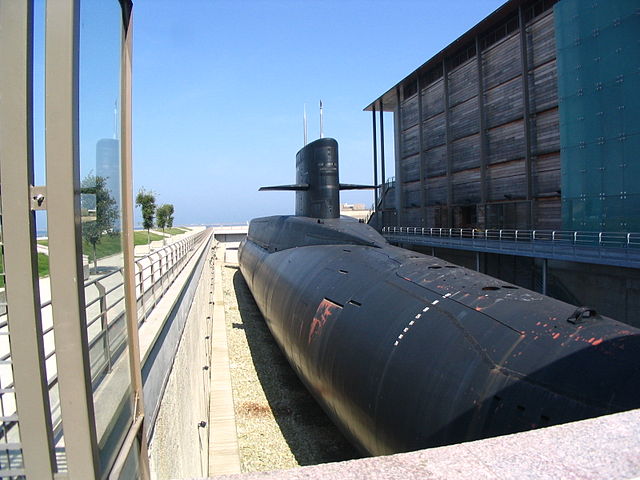
The class comprised six SSBNs all from Arsenal de Cherbourg and built one after the other: Le Redoutable (1967), Le Terrible (1969), Le Foudroyant (1971), L’Indomptable (1974), Le Tonnant (1977) and L’Inflexible (1982). This large gap allowed incremental improvements, but the first was discarded in 1991, at the very end of the cold war, followed by the others from 1996 to 2008 for the last one. They have been replaced by the Triomphant class since. The first was studied from 1985 and started in 1989, commissioned in 1996. Le Triomphant class ballistic submarine was also from Cherbourg, but larger to house tubes for the M51 ballistic missile.
Le Redoutable, never fitted with the M4 missile is now on display as a museum ship at the Cité de la Mer in Cherbourg, near her construction site.
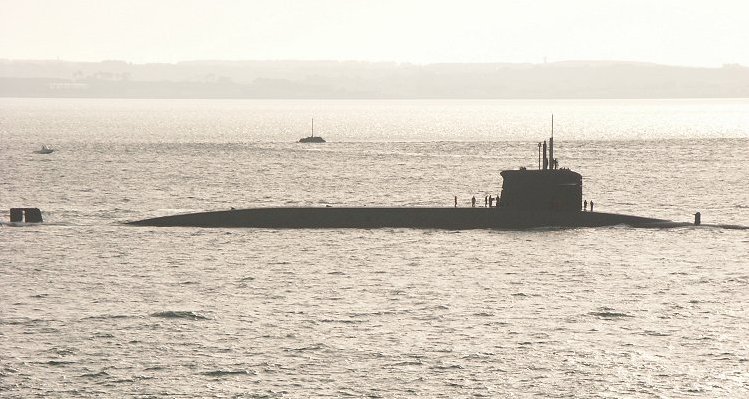
Agosta class SSK (1974)
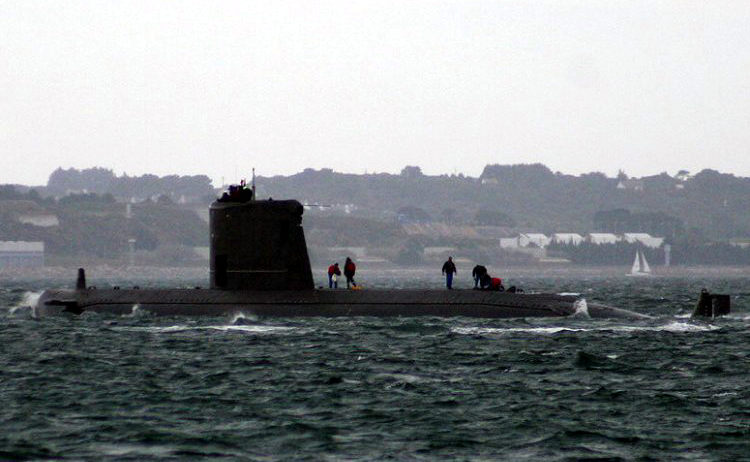
A brand new generation of attack submarines, and the last conventional French ones. The Agosta class were of double hull construction as the second hull was used for ballast, storage fuel and auxiliary tanks plus sensing heads for the acoustic suite. The outer shell had a cylindrical section refined as ellisptic at the front for better penetration, but it was still not “droplet” shaped. Design was made from the mid-1960s, alreay when the last of the previous Daphne class were launched. The final design came in 1971 and construction started in November 1972 for the first, Agosta, at Arsenal de Cherbourg like the others and the Redoutable class SSBN. Too small to carry nuclear reactors, the Agosta were conceived, not as escorts of SSBNs from Ile Longue (Brest), but hunters in the Mediterranean.
Nevertheless, they were well profiled and streamlined, much better than previous French subs, with recesses for deck fittings for a better waterflow. The diving planes were close to the bow, and there were no additional ones on the fin. But there were cruciform controls aft. Propulsion consisted in 320-cell battery with twice the capacity of the previous Daphne class. Max underwater speed was 17.5 knots, sustainable for one hour, 20.5 knots for 5 min. with a boost for evasive action. There was also a small 32 hp “creep” motor for silent operations, giving a top speed of 3.5 knots. The sensor suite comprised DUUA2 search and DSUV 22 passive array plus a crown of 36 hydrophones to provde a bearing on enemy noise emissions. The DSUV 62A towed array completed the suite by providing a large detection range. Torpedu tubes were reduced in number thanks to a new generation of vector, the L5/F17 wire-guided torpedo which had a high hit probably rate. The vector was discharged by a pnematic ram, performed at any depht or speed. The tubes were large enough to accept 550 mm torpedoes as well. The boats were provided with the DLA D3 Fire control system.
The Agosta (S620) was completed in 1977, Bezeviers the same year and date, while La Ptaya was completed in March 1978 and Ouessant in July 1978. Bézéviers became the tst boat for the new SM39 Exocet encapsuled torpedo missile. In the late 1980s, the three others were retrofitted this way. The four boats of the squadron served until the mid-1980s and were transferred in the Atlantic to replace the Narval class. The design attracted orders: Two were buit for South Africa (later resold to Pakistan), and four were built under licence by Spain for the Armada, completed in the 1880s. The Agosta class were the base for the Rubis class SNA.

Specifications:
Displacement: 1490/1740 tonnes
Dimensions: 67.2 x 6.8 x 5.5 m
Machinery: One shaft 2 SEMT Pielstick 320-16 and PA4 185 Diesels; 1 electric motor 3600/4600 hp.
Performances: 12/17.5 knots, range 8500 nm/9 knots, max depht 300 m
Armament: 4x 550 mm TT (bow 20 L5/F17 torpedoes)
Complement: 54
Rubis class SSN (1979)

The Rubis class was planned at the same time as the Redoutable class SSBN, but due to President Charles De Gaulle’s insistence for the nuclear deterrence program, budget and priorities pushed back the first French SSN to 1974, after the ballistic missile submarine program. The of the class was laid down in December 1976, launched in 1979, so 20+ years after UK, USSR or the USA. To accelerate development, engineers just adaptated the Le Redoutable nucear reactor to the small Agosta class hull, enlarged. So the Rubis became the smallest operational SSN worldwide.
The first three were to be named Provence, Bretagne, and Bourgogne but were renamed after the famous WW2 French minelayer submarine class, Rubis, Saphir, and Emeraude plus Casablanca, another successful FFL sub of WW2. They were completed in 1983-88 as the cold war ended, and so far only Rubis has been decommissioned. They were not highly successful. Although small and agile, they were estimated by a report to be noisy and slow, but that was the 1st generation French SSN. The 2020 the Barracuda class recalled the technological gap overcome in just 30 years.
In 1987, a Canadian White Paper recommended the purchase of abour ten Rubis or Trafalgar-class submarines, with technology transfer (Canada-class) it had advantages as not requiring USA permission to transfer nuclear propulsion technology while the French proposed the “ice pick” revision and modified torpedo tubes to launch Mark 48 torpedoes, but the program was abandoned in April 1989 as the cold war ended.
Specifications:
Displacement: 2385/2670 tonnes
Dimensions: 72.1 x 7.6 x 6.9 m
Machinery: One shaft nuclear CAS 48MW turbo-electric drive and motor, 9500 hp plus diesel APU
Performances: 25 knots, range: illimited, max depht 300 m
Armament: 4x 550 mm TT (bow 14 L5/F17 torpedoes/SM 39 Exocet SSM)
Sensors: DRUA 33 radar, DUUA 2B, DSUV 22, DUUX 5 sonars, DSUV 62 towed sonar.
Complement: 66
Amethyste class SSN (1988)

The Rubis was good but recoignised as noiser than other NATO SSNs, so this conducted to a revised design, with nois reduction as a priority. Indeed, the silencing program was called AMÉlioration Tactique HYdrodynamique Silence Transmission Ecoute (Silent Acoustic Transmission Tactical Hydrodynamic Improvement) the accronym fitting the name of another diamond, S605 Améthyste. The second (or sixth Rubis) was S606 Perle. The hull was 73.6 metres (241 ft) so slightly longer but completely reshaped in order ro reduce acoustic signature, and coated with an absrobent material, while there were upgrades to the sonar, and the electronics. After bein tested and proven, the next two, S607 Turquoise and S608 Diamant were cancelled as the cold war ended, while the original four Rubis boats were rebuilt to the same standards between 1989 and 1995, while Amethyste and Perle were completed in 1992 and 1993. All were built at Arsenal de Cherbourg, the traditional atlantic coat French submarine construction yard. All are in service today. The next generation, replacements of the Rubis-Amethyste class was the Barracuda class (ongoing). Suffren, the lead ship, was launched in 2020.
Specifications:
Displacement: 2400/2670 tonnes
Dimensions: 73.6 x 7.6 x 6.4 m
Machinery: same
Performances: same
Armament: same
Sensors: same but DRUA 33, DMUX 20 sonar, DSUV 62C towed sonar.
Complement: 66
Issole class LST (1957)
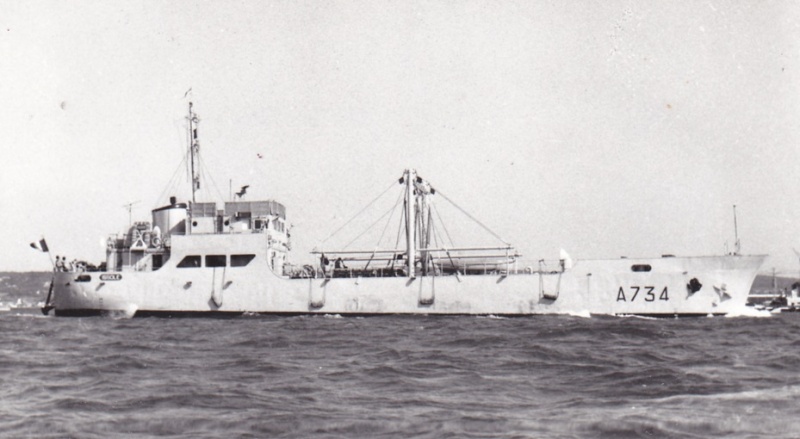
BDC Issole. SRC
A single experimental LST built in Tulon and adapted from a civilian coaster in 1957-58. She had bow doors and hydrualic ramp, named A734. At 900 tonnes, 48.7x 7 x 2.1 m (161 x 23 x 7 feets), two shafts, two diesels for 100 bhp and 12 knots, she became in the 1970s a coastal transport as A734, stricken in 1979.
Trieux class LST (1958)

The lead ship was laid down at the Ateliers et Chantiers de Bretagne, Nantes in April 25, 1958. This was the first serial French tank landing ship. It was named Trieuxin 1956 after a small coastal river in Brittany. Launched on December 6, 1958, it entered service on March 18, 1960.
Trieux was assigned to the 4th maritime region, first in a series of five LSTs, Argens, Blavet, Dives and Bidassoa (rivers). They were called BDC in the French termonology for Batiments de débarquement de chars.
The LST Trieux began her career in Algeria, in 1962, covered by the aircraft carrier La Fayette, and sister ships BDCs Blavet and Argens, repatriating 17,500 French and Harkis from Algeria to France. however her carrie brought her to the Pacific, from 1966, to 1973 until she was disarmed, used with a helicopter hangar and Based in Papeete, for nuclear tests of the Pacific Experimentation Center. She suppled Mururoa and Hao atolls and carried troops of the RIMAP for exercises. She was decomm. in Papeete in 1988, replaced by Bougainville, but BU in 1992. Her sister ships were stricken in 1985-86.
EDIC class LST (1968)
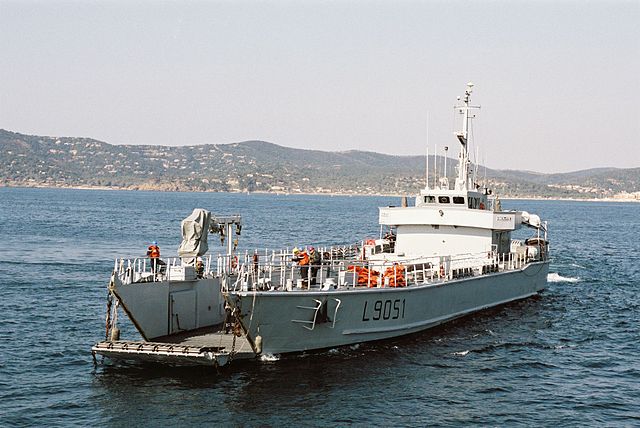
EDIC meant “Engin de Débarquement infanterie Chars” (lit. Landing Craft Infantry Tanks”). They were 700 tonnes vessels built in three groups. The first L9091-93 were launched in 1968, L9070-74 in 1967-69 and L9091-96 in 1987 so thirteen in all. Specs: 635/736 t FL, 59 x 12 x 1.3 m, 2 shafts MGO diesels, 1000 bhp 8 knots, range 1800 nm at 8 knots. Armament: Two 20 mm, two 12.7 mm MG. These LCs can carry eleven trucks and four LVTs. The last two, called EDIC III have a better powerplant, SACM M60 V12 ASM diesels, 14,000 bhp for 12 knots.
In between, four EDA (Atelier, “workshop”) were launched in 1964, numbers L9081-84 used as logistic and repair ships for overseas stations while L9084 became an auxiliary electrical stor ship or BAME. L9051 and 9052 served in the pacific. Exports: Two EDIC III for Lebanon. So far, six stricken in the late 1980s and two 1991, one sold to Madagascar, and one to Senegal. They had a ECCA radar and were armed with two 20 mm modèle F2 guns, and two 12.7 mm M2HB. Payload 200 tonnes, 180 equipped infantry, crew 10.
CDIC class LST (1988)
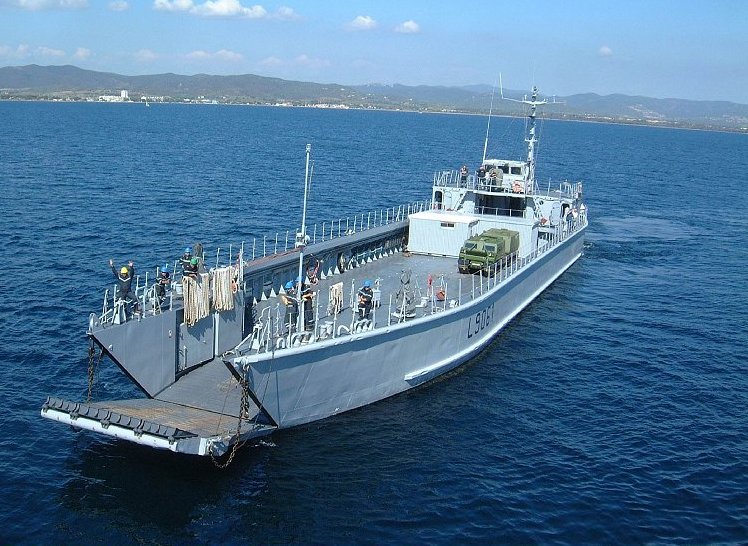
CDIC means “Chaland de débarquement d’infanterie et de chars“. Two LSTs were built by SFCN, Villeneuve-la-Garenne, called Rapière and Hallebarde, commissioned in 1988-89. They displace 380 tonnes light and 710 fully loaded and are specialized in tanks transport. There is a small wheelouse that can be lowered to facilitate loading. Due to delays in the TDC program, further orders were cancelled. The second vessel is in service today. Rapiere was sold in 2011 to Chile as Canave.
No photo – (To Come)
Champain class Landing Ships (1973)
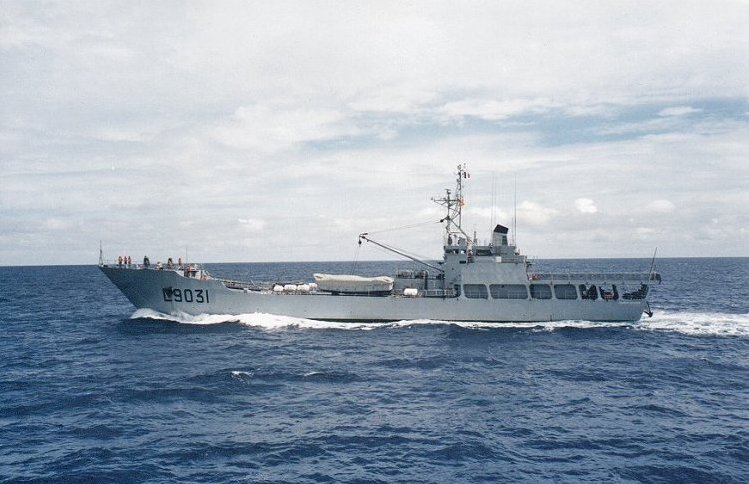
The BATRAL (Bâtiment de Transport Léger) were designed as long range 1380 tonnes FL tank transports for overseas service. The first two, Champlain, Francis Garnier were built at Arsenal de Brest in 1973. Displacement 750/1330 tonnes, 80 m oa x 13 x 3 m, 2 shafts diesels SACM V12, 3,600 bhp, 16 knots. Armed with two 40mm or 20mm AA guns and two 81 mm mortars. Radar DRBN 32. Can carry 180 troops and light vehicles or 400 tonnes of material. They also have a landing platform fo a light helicopter aft. The other three, Dumont D’Urville, Jacques Cartier, La Grandière were built at Atelier français de l’Ouest in 1981-85, and displacing 770 tonnes/1386 tonnes FL. All decommissioned today. Exports: Chilean Rancagua (R92), Chacabuco (R95), Maipo (R91), L’Elephant for Ivory Coast, President el Hadj Omar Bongo for Gabon, Daoud Ben Aicha, Ahmed Es Skali, Abou Abdallah El Ayachi for Morocco.
Ouragan class LSD (1963)
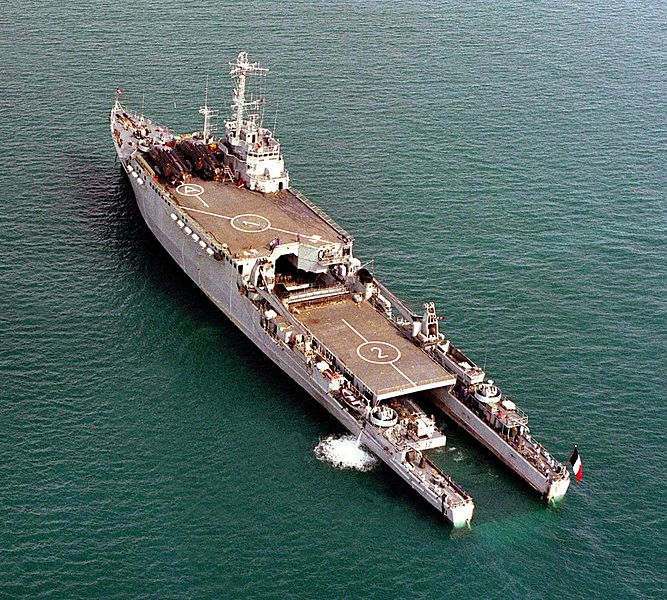
The Ouragan class were the first French Dock Landing Ships, both built at Asrenal de Brest, launched 1963-67, called in french TCD (Transport de Chalands de Debarquement). They can lift a commando, put to shore via helicopters like a an assault transport and use landing crafts to land supplies and tanks. Clearly inspired by USN LSDs, they are more versatile in some ways, by using removable sections of deck, internally and externally so to increase capacity in both ways.
Their main docking well is 120 m long, with flooding up to 3 meters. Th stern gate is 14 x 5.5 m. So two EDIC can be launched for a total capacity of 22 light tanks of AFVs. Eighteen LCM(6) can be operated as well. Water control sluices are managed by pumps and valves automatically, from a central CP. In logistic missions, the ship can carry 1,500 tonnes of matériel in its cargo zone. There are two 35 tonnes cranes installed aft, above the docking well. The ship also can carry 18 super-frelon heavy ASW helicopters, 18 Alouette light helicopters, 120 AMX-13 tanks, landed in successive waves, 84 DUKW, 340 jeeps or twelve 50 tonnes barges. To make more room on dekck these ships also have a small island starboard with all sensors, command bridge and a central CP for coordination of landing operations.
The main helicoper deck can be lenghtened of 36 meters in six sections over the dock, with a surface allowing to operate four super-frelon used to carry troops (38 each), screened by two light Alouette/Gazelle recce/attack helicopters, or only the latter, 13 in all with all the spots available. Three LCVPs are carried topsides for an additional 350 troops quick landing solution. When enlarged by removing landing deck sections, the ship could be converted as floating drydock for a 400 tonnes vessel and the cargo bay transformed into a workshop as maintenance and repair ship.
Ouragan was laid down in june 1962, completed in 1968. Orage, her sister ship, was completed as used by the Pacific experimental centre (atomic). Her armament was removed and she was converted into a medical unit and floating HQ, with decontamination areas. Both were in Toulon in the 1990s, retired 2007, sold for BU in Ghent 2017 for scrapping.

Specifications:
Displacement: 5800/8500 tonnes
Dimensions: 149 x 21.5 x 5.4 m
Machinery: 2 shaft SEMT pielstick 12PC 2V diesels, 8640 bhp 17 knots, range 2000 nm at 15 knots.
Armament: Two 120 mm mortars, 4 x 40 mm AA on ouragan.
Sensors: SQS-17 sonar on Ouragan
Complement: 211 crew, 470+ troops.
Bougainville LSD (1986)
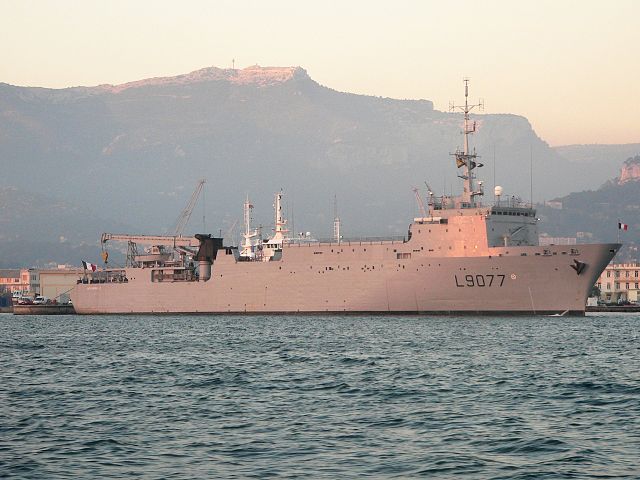
The Bougainville was an experimental DLS built at Dubigeon, Nantes NyD. Called BTMS for Bâtiment de Transport Moyen et de Soutien, she was launched in 1986 as a possible replacement for the Orange deployed in the Pacific for atomic experiments, operating between Papeete and Mururoa test centre. A scaled-down version of the TCD 90 (Foudre class), she had a 78 x 10.2 m docking well. She could operate three CTM type landing crafts or 40x 20 tonnes containers. Stern door was 10 x 6 m. There is a fixed 37 tonnes crane starboard and travelling crane of 25 tonnes. Vehicles can embark or disembark via the side door and 6m ramp. She can also operate as a floating drydock with the capacity to hold a L’Audacieuse class patrol ship. The flight deck measures 26x 17m, and pumps automatically stabilize the ship in all weathers for helicopter operations. She generally operates two super-Puma helicopters. For logistic and support role she had an autonomy of 45 days, at low speed, two bow thusters for manoeuvers, double berth that can house 50 civilians, 53 crew and 500 troops.

Specifications:
Displacement: 4200/4870 tonnes
Dimensions: 111,5 x 17 x 4.2 m
Machinery: 2 shaft SACM MGO 195 V12 diesels, 4,800 bhp, 14.6 knots, range 6000 nm at 12 knots.
Armament: None but two Super Puma helicopters
Sensors: radar DRBN 32
Complement: 53 crew, 50 civilians, 500 troops.
Foudre class LSD (1988)
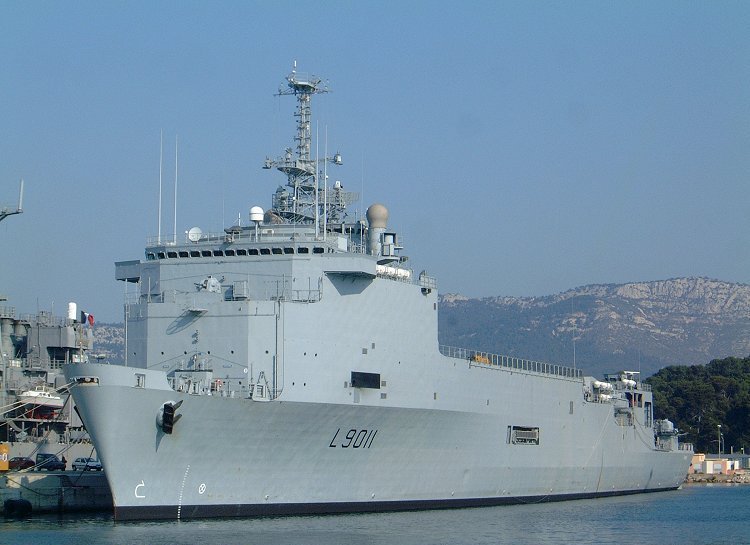
L9011 Foudre and L9012 Siroco called TCD 90 are dock landing ships, a repeat, but improved in all areas, of the 1960s Ouragan class. They were designed as replacement for the former, three ordered under the 1984-88 programme and one projected for the next. However due to budgetary problems only two were voted, the second, Siroco, authorized in 1994, in service by 1998. Both now ae decommissioned, Foudre in 2011, Siroco in 2015. The latter was sold to Brazil, and is now Bahia, the first to Chile, as Sargento Aldea. Both has been replaced by the larger BCP of the Mistral class assault ships in the 1990s.
They repeated the principle of the Ouragan, and were designed around the 350 me strong Force d’Action Rapide with 1080 tonnes of cargo and supplies. The ship was also setp to serve as mobile maintenance and drydock, support ship. Compared to its 1960s predecessor, the Foudre is faster, with a better range, allows a higher transit speed, could house and maintain four Super Puma helicopters in a dedicated hangar blended in the superstructure bridge, had a 52 tonnes elevator connecting the docking well to the cargo hold, side ramp, permanent accomodations for 470 troops, advanced hospital facilities below the helicopter deck for fast transfer of casulaties repatriated by air.
The docking well measures 122 x 13.5 m, housing ten 24 m CTM landing craft, two CDIC while two LCVP are hoisted on the sides davits. The docking well could operate the 400 tonnes super PATRA, Chamois class BSR, RR 2000, and coastal tuges. There is a single 37 tonnes crane starboard near the superstructure and another aft, transfer mech for machinery, heavy equipments, well equipped workshops. The 50 m flight deck could operate two super Puma helicopters simultaneously from its spots, and by adding five 6m sections aft, another spot. The powerplant was copied over the Durance class supply ships and the hull had bow thrusters, pumps and stabilizers for operations in all weather. There is also a computer based CP for docking operations and a HQ with advanced communication, including the Syracuse satcom system. Also both ships were better armed, with two twin Simbad SAM and one 40 mm, two 20 mm AA. The Siroco and next two as planned were to have a breda-Mauser 30 mm CIWS and DRBV 21 radar.

Specifications:
Displacement: 9,300/11,880 tonnes
Dimensions: 168 x 23.5 x 5.2 m
Machinery: 2 shaft SEMT Pielstick 16PC V400 diesels, 21,600 bhp, 21 knots, range 11,000 nm at 15 knots.
Armament: 2×2 Simbad SAM, 1x 40, 2x 20mm AA, four Super Puma helicopters
Sensors: radar DRBV 21A
Complement: 210 crew, 350 civilians, 1200 troops.
Le Fougueux class Sub-Chasers (1958)
Le fougueux, L’opiniatre, L’Agile, L’Alerte, L’enjoue, L’intrepide, L’Ardent, L’Etourdi, L’attentif, Le Hardi, L’effronte, Le Frondeur.

These ships were inspired by USN PC-boats of WW2 (of which 30 were acquired in 1944) built built in France, between CMN Cherbourg, AC Augustin Normand, AC Dubigeon and FC de la Mediterranée, all funded by MDAP. Five authorized in 1955, six 1956, launched 1954-1959. Others were built for Yugoslavia, Tunisia, Portugal and Ethiopia. After the first three, changes were made to the bridge structure, armament. l’Intrepide tested a single torpedo tube above the stern. 325/400 tonnes FL, 53.1 x 7.3 x 3.1 m, 2 shaft SEMT Pielstick fast diesels 3240 bhp, 19 knots. Armament: 2x 40 mm AA, 2x 20 mm AA, 1x 120 mm ASWRL, 2 Hedhehog, 2 DCT, 1/2 DC racks. Sonar QCU-2, crew 62. Stricken 1977-82.
La Combattante type patrol craft (1963)
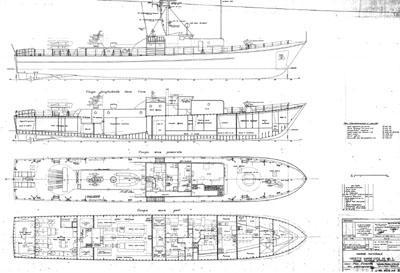
Plans of the ship, in low-res (Src alabordache.fr)
This famous cold war French ship was a prototype of a successful Patrol ship called “Patrouilleur garde Côte”. She was made in CMN, Cherbourg using innovative construction technique with laminated wood and composites fr a low magnetic signature. She was launched 20 June 1963 and extensively tested, the first French patrol ship, planned to be armed with the redoubtable Exocet missile for Germany. She was to be the head of a large export serie.
Specs: 180/202 tonnes FL, 45 x 7.4 x 2.5 m, propelled by two shafts SEMT-Pielstick 8PA 200 VG DS diesels for an output of 3600 bhp and 23 knots, range 2000 nm/12 knots.
They were armed with a quadruple canister of SS-11 SSM missiles*, one 40 mm AA, two 12.7 mm M2HB HMGs. Later this was changed in the early 1970s with addition of a second 40 mm, then 14-tubes flares launcher. In 1978 she was tested in the Indian ocean, with 80 me onboard. In 1979 she was given more modern diesel engines, PA 4 VG DS using a 2-stage supercharging unit and variable-geometry precombustion chamber, to reach 4000 bhp and 24-25 knots. La Combattante served also in the Pacific but ended in the Mediterranean, used by the Gendarmerie at Toulon. As expected, the model was well sold:
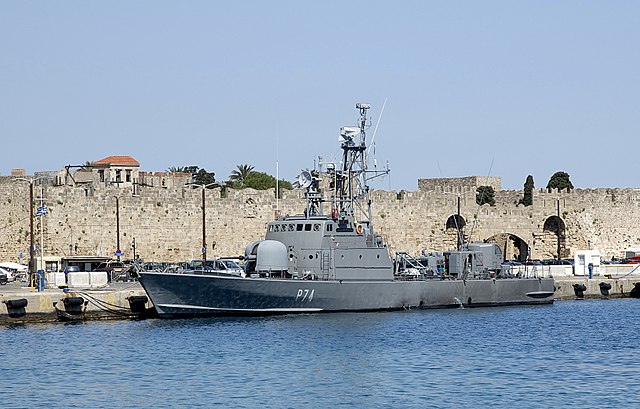
La Combattante I was designed with Germany and for the Bundesmarine. It combine the Exocet missile with a Lürssen design. Twenty vessels were built in CMN, Normandie and Lürssen as the 148 Tiger-class fast attack craft. Later they were discarded an resold to Greece, Chile and Egypt or decommissioned in 2003. Between 1968 and 1974 CMN built 37 more ships under the name La Combattante II: They were ordered by Iran (12 Kaman class), Malaysia (4 Perdana class) Libya (9 Beir Grassa class) and CMN revised the design on precise specs for Israel: 12 more fast attack craft called the Sa’ar 1-3 classes, armed wit the local Rafael SSM (see the IDF navy).
Their final displacement was around 234 tons, for 47 metres in length, and generally had an OTO Melara 76mm gun forward, four Exocet missiles in amidships canisters and a 40 mm Bofors aft, and they can also carry eight mines. They were powered by four MTU MD 16V 538 TB90 diesels, offering 12,000 hp (8,900 kW) combined for 36 knots (IIa). In 1975, CMN revised design, making a nine metres longer hull at 56 metres to improve seaworthiness and extra room, for 359 tons, as La Combattante III. Until 1990, 19 vessels were built for Greece, Tunisia, Qatar, and Nigeria plus the Israeli the Sa’ar 4 class between France and under licence in Israel. The latter also built and assisted South Africa under embargo for its own class. Also derived from these designs are the nine Iranian Sina class ships, classed as FACs due to their speed.
Trident class patrol crafts (1976)
Trident, Glaive, Epee, Pertuisane
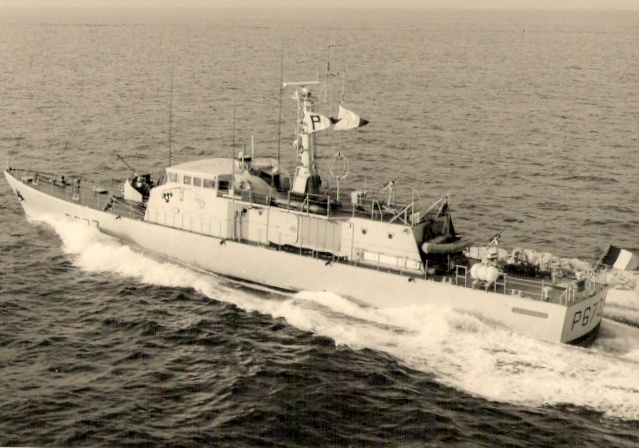
The paradox is FACs were not required in France service, which preferred slower boats purely made for patrolling the world’s second largest Exclusive economic zone and immense oceanic possessions. The trident class was named internally in the French Navy as the PATRA class PBs. Four ships, built at Auroux Yard, Arcachon and CMN Cherbourg, the forerunner of a serie of 30 ships as planned by the Plan Bleu, half for overseas service. But they soon proved too small for effective use, launched in 1976.

Specs: 112/148 tonnes FL, 38.5/40.7 x 5.9 x 1.6m, 2 shafts AGO 195 V12 CZSHR diesels, 5000 bhp and 28 knots. Their range was 1500 nm at 15 knots.
They were armed with six single canister with SS.12 SSM* (later removed), one 40 mm Bofors and a single 12.7 mm M2HB HMG. They were all retired in the 1990s/2000s.
Note: A single ship, Sterne (P680), was built to mercantile standards for fishery protection for the ZEE, wit funds provided by the owners but the ship was manned by Marine Nationale personel. She was launched at A&C De la Perière Lorient, in October 1979, equipped with a large infirmary, and active stabilization system, plus hydraulic drive for economic cruising at 6.5 knots.
Specs: 270/380 tonnes, 49 x 7.5 x 2.8 m, 2 shafts SACM V12 CZSHR diesels 4200 bhp 20 knots, armed with two 12.7 mm HMG, radar DRBN 32. She was disarmed in 2009.
*The SS.11/SS.12 missile family was a log shot from the Exocet. These, made by Nord, were small wire-guided models also used by aviation and tanks. They had a 28 kgs warhead and 7000/8000 m range at Maximum speed 370 km/h.
L’Audacieuse class patrol crafts (1984)
Audacieuse, boudeuse, Capriceuse, Fougueuse, Glorieuse, Gracieuse, Moqueuse, railleuse, Rieuse, Tapageuse. P682-691
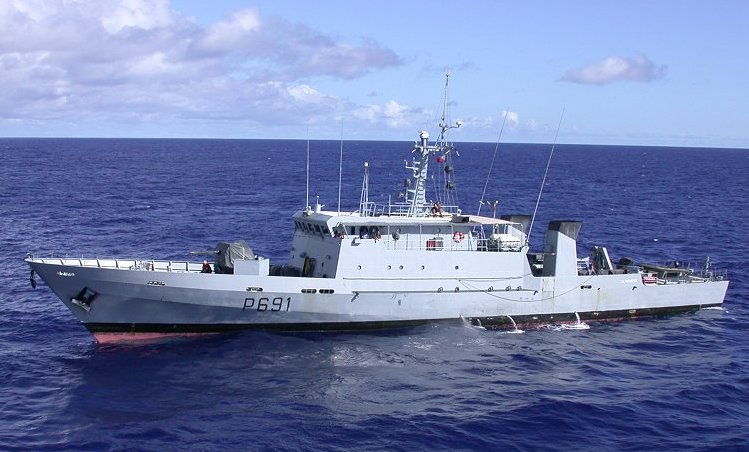
Better known as the “super PATRA”. These larger boats were a better fit to patrol the French ZEE and ten were built in 1984-87 at CMN Cherbourg. More seaworthy and powerful they had no missiles, only guns. They had an intermediate role including fire-fighting SAR and anti-pollution duties. Propulsion problems delayed the completion and corrections made from 1990. Instead of funnels indeed they had underwater exhausts. They also had two large holds and an hydraulic crane to transport a substantial payload, ideal for remote islands, as well as accomodations for 20 passengers. Provisions were made also to fit two exocet missiles in wartime and FCS, radar. The first ships tried the new Sonar Thomson-CSF VDS-12 in 1985. Seven has been retired, the other sold to Gabon and Kenya.

Specs: 406/454 tonnes, 54.5 x 8 x 2.5 m, 2 shafts Alsthom/SEMT 16PA V200 VGDS diesels 8000 bhp, 24.5 knots 4200 nm. 1x 40, 1x 20 2x 12.7mm AA, radar DRBN-32.
Note: An extra ship, called Grebe (P679) was built as PB/Fshery protection vessel, by SFCN yard, Villeneuve la Garenne, launched in 1989. Lighter than the super-PATRA type it seems only one was built, which served in the Mediterranean and was sold in 2010 to Cameroon, now named Dipikar.
Sirius class coastal minesweepers (1952)
M701 (Sirius) to M759 (Lyre): 34 vessels
In all, thirty-four minesweepers were built in france by Arsenal de Cherbourg, Penhöet, AC de la seine maritime, CMN Cherbourg and Augustin-Normand, 28 funded under MDAP, the offshore contract derived from the Marshall plan, and three more for Yugoslavia, launched 1952-56. Also called type D, they had close characteristics with the British “Ton” class as the design was developed in collaboration with Thornycroft. The hull however was made of laminated wood and aluminim, both rigid and light. The keel and stern were made of heavy wood. They were fitted with advanced acoustic equipments and eep gear. Some also had an advanced degaussing system. Some ships were fitted with SEMT Pielstick diesels instead of the Alsthom or Rateau-Bretagne gas turbines. Propulsion was indeed unusual, as their construction: They had two shafts connected to SIGMA free piston generators-turbines compound. These experimental powerplant presented an alternative to diesels, offering the same advantages. They presented mechanical simplicity, compactness, excellent torque-speed characteristic and fuel economy.
Some became station ships and PBs in the 1960s-70s, or discarded. Tactically they were called in “Esdra” (squadrons) and “Didra” of 3-5 boats based in various locations. More. They were just a part of a large fleet of such vessels transferred from the US (15 Agile class, 30 Adjutant class) and Canada (6 Bay class) needed to cean up all minefields of the northern sea and mediterranean, in order for trade to restart. They were also financed under MDAP, but had a very long carrier in French service, the last decomm. in the 1990s, like Baccarat, Alençon and Ouistreham (Agile class).
Mercure:
Also in 1957 was launched a variant called Mercure. This coastal Minesweeper called DBI in french Navy parlance was to be the lead ship of a new class based on the USN MSC type or Aacia class, financed under MDAP. If the class was not pursued in France, six ships of this class would be built for the Bundesmarine by CMN Cherbourg.
It had a hull made in laminated wood assembled/glued under high pressure with anti-magnetic longitudinal metal bonding. The navigation bridge was made in light alloy, and the propulsion and generators were mounted to absorb schocks while they could be operated from the bridge in operation, not to risk any crew below the waterline. The ship was equiped with German diesels, a pair of MTU providing 4,000 hp for 15 knots and a range of 3000 nm, however they were not satisfying and after some time in reserve, she was modified in Cherbourg as a fihery protection vessel with new MGO 2500 diesels, eventually stricken in 1990.
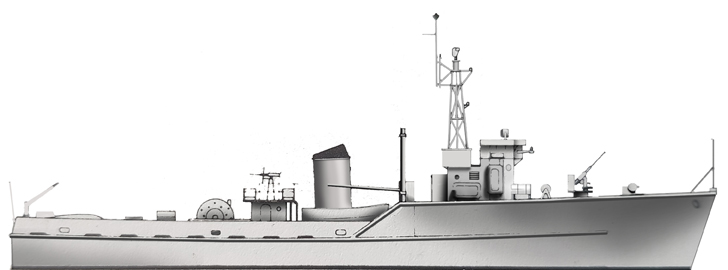
Specifications:
Displacement: 365/424 tonnes FL
Dimensions: 42.7/46.4oa x 8.6 x 2.5 m
Machinery: 2 shaft SIGMA FPG, steam Turbines, 2000 hp, 15 knots, range 3,000 nm at 10 knots.
Armament: 1x 40, 1/2x 20mm AA
Sensors: radar DUBM 41
Complement: 38
Circé class minehunters (1972)
Circe, Calliope, Clio, Cybele, ceres M712-716
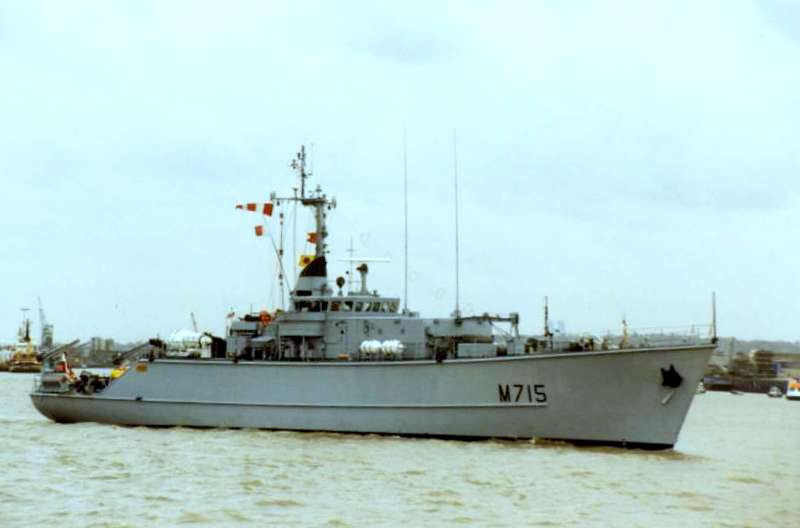
This class of modern minehunters were designed to gradually replace the MDAP ships of the 1950s. Five were built at CMN Cherbourg, launched 1970-72. They were the first purpose-built minehunters. The entire ship, of composite construction (see later) was designed to operate the DUBM sonar, with a PAP 104 minhunting vehicle handled by a large articulated davit at the stern. The sonar allowed detection at 60 m depht, 500 m around the ship. This allowed remote mine destruction at safe distance, while the operators are housed in a superstructure block in front of the bridge. Construction called for the use of GRP: This was a sadnwhich construction, with blocks of wood and foam interwoven in an outer skin of wood coated with GRP. Superstructures were made of composite wood and glass resin. For propulsion, there was a MTU diesel for cruising and twin active rudders for mine operations, operating at 7 knots. Each of these active rudders had a small propeller mounted at its base, propelled by a 260 bhp electric motor. Operation was remote, from the bridge or a deicated room, soundproof control located above the main deck.
The last ship of the class, Ceres, was the test ship for the new automatic plotting table EVEC, later retro-fitted to other ships of the class. They had been retired and replaced in the late 1990s by the Vulcain and Antares class, while the Eridan are still in active service.
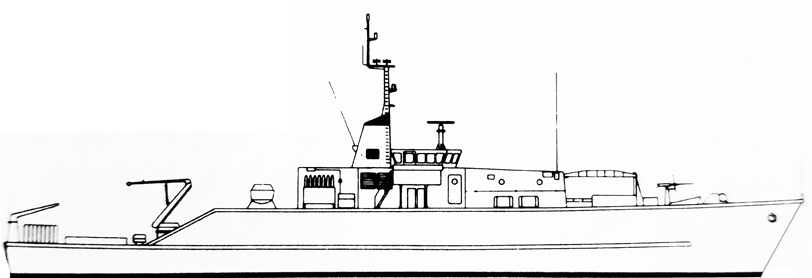
Specifications:
Displacement: 460/510 tonnes FL
Dimensions: 50.9 x 8.9 x 3.6 m
Machinery: 1 shaft MTU diesel 1800 bhp, 2 AC electric 520 bhp, 15 /7 knots, range 3,000 nm at 12 knots.
Armament: 1x 20mm AA, 2 PAP 104 minehunting crafts
Sensors: Sonar DUBM 20, radar Decca 1229
Complement: 45
Eridan class minehunters (1979)
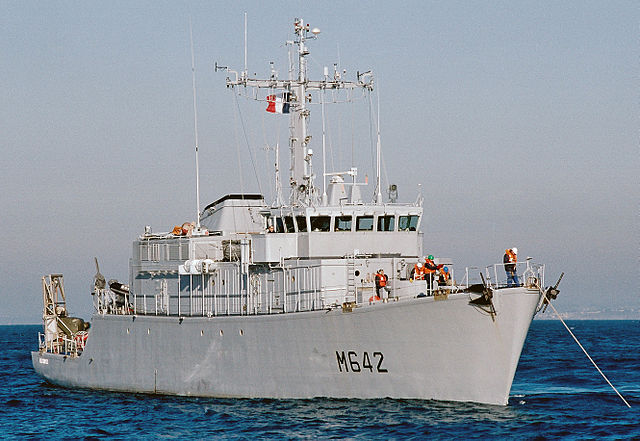
This second generation minehunter was developed on a larger scale in the “Tripartite” program between France, the Netherlands and Belgium, which adopted the same system. 11 ships were built in France alone, at Arsenal de Lorient, between 1978 and 1992, so they basically were improved Circe class. All hulls were of the same GRP-based design, the French provided the minhunting and electronic equipments, the Netherlands provided the propulsion system (Brons-Werkspoor A-RUB 215 V12 diesel) and Belgium the minhunting propulsion system and electric motors. The hull was divided into partitions of single GRP skin 20 to 40 mm thick, as the deck, stiffened by trapezoid section formers and connections reinforced by fiberglass pins. The whole hull is molded in the same steel shell. Propulsion is the same system with the addition of bow thrusters for steadiness during operations. On the French vessels, the latter are propelled by three Astazou IVB gas turbines (from helicopters) of 140 KW each. There is a fourth diesel-electric generator for electrical supply, 160 KW. The single five-bladed propeller could be feathered in operations, remote controlled like the former Circe class.
The new DUBM21B provided by the French is a smaller and more advanced model for detecting and classifying moored and ground mines down to 80m. This system is retractable when cruising. Minesweeping capabilities are somewhat reduced, wuth light sweeping gear and from 1985 AP4 acoustic gear. The PAP 104 is unchanged, with 27 explosives charges in store. The control center features the EVEC 20 plotting table coupled with the inertial navigation system. There is also a Decca Hi-Fix and Sydelis radio precision navigation system onboard. The ship can also carry a 5 tons multipurpose container, which can be used for drone control. originally the french Navy ordered 15 ships, but ten were delivered under budgetary constraints, over a much larger time than initially planned. Six units operated to “clear the way” for the French SSBN at Brest, assisted by the dedicated supply ship Styx. The others are in Toulon, they replaced the fairly old Agile class ships. One unit, Sagittaire, was sold to Pakistan in 1992.
Specifications:
Displacement: 526/595 tonnes FL
Dimensions: 51.6 x 9 x 3.5 m
Machinery: 1 shaft Brons-Werkspoor diesel, 1,900 bhp, 2 AC electric, bow thruster, 15/7 knots, range 3,000 nm at 12 knots.
Armament: 1x 20mm AA, 2x 12.7 mm AA, 2 PAP 104 minehunting crafts
Sensors: Sonar DUBM 21B, radar Decca 1229
Complement: 55
Vulcain class diving tenders (1986)
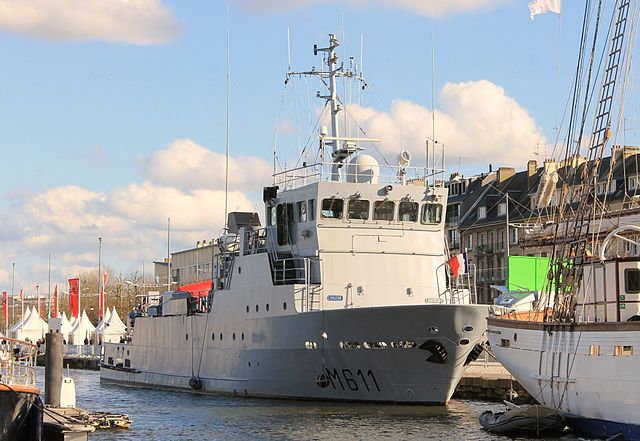
These four vessels are dedicated tenders of the French miesweepers and mine hunter divers groups called BBPD. Two were built at La perière, Lorient (Vulcain, Pluton), and two at CMN Cherbourg (Acheron, styx), named after hell’s rivers. Launched 1986-87, they were improved version of the old Chamois class, and replaced the US Adjutant class. Their main rôle is diving support, and they can operate fifteen of them on inflatables carried abaft the funnels. They operates a single hydraulic crane 3.5-5 tonnes cap. and the bridge is equipped with a Sydelis precision navigation system. The ships operated from Cherbourg, Brest, and Toulon, a second kept for training there.

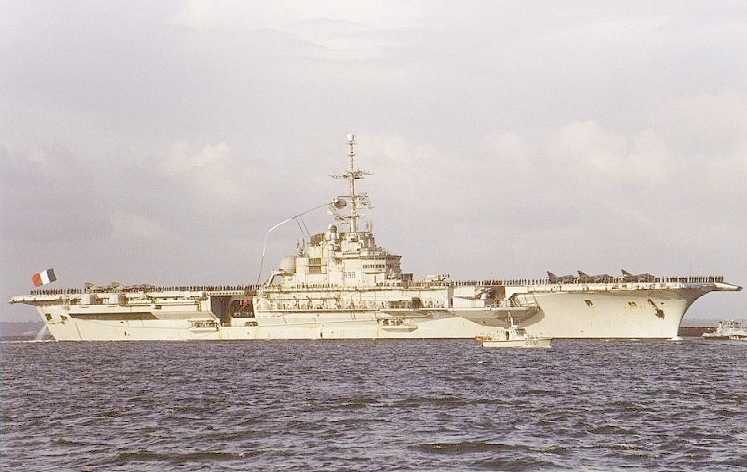

 Latest Facebook Entry -
Latest Facebook Entry -  X(Tweeter) Naval Encyclopedia's deck archive
X(Tweeter) Naval Encyclopedia's deck archive Instagram (@navalencyc)
Instagram (@navalencyc)





 French Navy
French Navy Royal Navy
Royal Navy Russian Navy
Russian Navy Armada Espanola
Armada Espanola Austrian Navy
Austrian Navy K.u.K. Kriegsmarine
K.u.K. Kriegsmarine Dansk Marine
Dansk Marine Nautiko Hellenon
Nautiko Hellenon Koninklije Marine 1870
Koninklije Marine 1870 Marinha do Brasil
Marinha do Brasil Osmanlı Donanması
Osmanlı Donanması Marina Do Peru
Marina Do Peru Marinha do Portugal
Marinha do Portugal Regia Marina 1870
Regia Marina 1870 Nihhon Kaigun 1870
Nihhon Kaigun 1870 Preußische Marine 1870
Preußische Marine 1870 Russkiy Flot 1870
Russkiy Flot 1870 Svenska marinen
Svenska marinen Søværnet
Søværnet Union Navy
Union Navy Confederate Navy
Confederate Navy Armada de Argentina
Armada de Argentina Imperial Chinese Navy
Imperial Chinese Navy Marinha do Portugal
Marinha do Portugal Mexico
Mexico Kaiserliche Marine
Kaiserliche Marine 1898 US Navy
1898 US Navy Sovietskiy Flot
Sovietskiy Flot Royal Canadian Navy
Royal Canadian Navy Royal Australian Navy
Royal Australian Navy RNZN Fleet
RNZN Fleet Chinese Navy 1937
Chinese Navy 1937 Kriegsmarine
Kriegsmarine Chilean Navy
Chilean Navy Danish Navy
Danish Navy Finnish Navy
Finnish Navy Hellenic Navy
Hellenic Navy Polish Navy
Polish Navy Romanian Navy
Romanian Navy Turkish Navy
Turkish Navy Royal Yugoslav Navy
Royal Yugoslav Navy Royal Thai Navy
Royal Thai Navy Minor Navies
Minor Navies Albania
Albania Austria
Austria Belgium
Belgium Columbia
Columbia Costa Rica
Costa Rica Cuba
Cuba Czechoslovakia
Czechoslovakia Dominican Republic
Dominican Republic Haiti
Haiti Hungary
Hungary Honduras
Honduras Estonia
Estonia Iceland
Iceland Eire
Eire Equador
Equador Iran
Iran Iraq
Iraq Latvia
Latvia Liberia
Liberia Lithuania
Lithuania Mandchukuo
Mandchukuo Morocco
Morocco Nicaragua
Nicaragua Persia
Persia San Salvador
San Salvador Sarawak
Sarawak Uruguay
Uruguay Venezuela
Venezuela Zanzibar
Zanzibar Warsaw Pact Navies
Warsaw Pact Navies Bulgaria
Bulgaria Hungary
Hungary

 Bundesmarine
Bundesmarine Dutch Navy
Dutch Navy Hellenic Navy
Hellenic Navy Marina Militare
Marina Militare Yugoslav Navy
Yugoslav Navy Chinese Navy
Chinese Navy Indian Navy
Indian Navy Indonesian Navy
Indonesian Navy JMSDF
JMSDF North Korean Navy
North Korean Navy Pakistani Navy
Pakistani Navy Philippines Navy
Philippines Navy ROKN
ROKN Rep. of Singapore Navy
Rep. of Singapore Navy Taiwanese Navy
Taiwanese Navy IDF Navy
IDF Navy Saudi Navy
Saudi Navy Royal New Zealand Navy
Royal New Zealand Navy Egyptian Navy
Egyptian Navy South African Navy
South African Navy






























 Ukrainian Navy
Ukrainian Navy dbodesign
dbodesign